


Cerro Gordo County Iowa
Part of the IaGenWeb Project
|
The Globe Gazette


TRANSCRIBER'S NOTE: Some of the language contained in these news articles are not considered to be politically correct by today's standards. They have, however, been transcribed as they appeared in 1953.
THE PIONEER YEARS ~ 1853 - 1869 * * * * * * * * * * * * * * * * * * * * * * * * * THE MASON CITY STORY [Section 7, Page 2] This is the story of how there came to be built a city of 30,000 on the spot where a farsighted pioneer put up the first cabin exactly 100 years ago [1953]. it is mostly the story of courage, thrift, resolution, sacrifice and faith. These resourceful pioneers had first to conquer a wild, relentless prairie, which exacted its inevitable toll. They built a community they wanted to be a center, not only for trade and industry, but for religious, cultural and educational attainments. They insisted on good government. Through their efforts the village became a city, as railroads, highways, factories and stores were built. As their numbers grew there became manifest a strong, persistent common spirit among them that expressed itself in towering projects for the public good. We hope this story of Mason City's past will suggest to the Mason City of today a renewal of those sturdy virtues of the pioneers, that there will emerge from this centennial observance a new impulse for the building of a greater Mason City and that the past century will prove but a prologue of things to come.
MASON CITY MAYORS LISTED [Section 7, Page 2] Since Mason City became an incorporated village in 1870 this community has had 38 mayors. They are listed below with the dates in which they served:
NOTE: Source for mayors, years 1954 to 2014: masoncity.municipalcms.com/docview.aspx?docid=36840
STATISTICAL FACTS ABOUT MASON CITY Growth In Population [Section 7, Page 2]
Altitude - First Street and Federal Northwest . . . . . 1140 Feet
MASON CITY A SMALL VILLAGE IN CIVIL WAR YEARS [Section 7, Page 2] 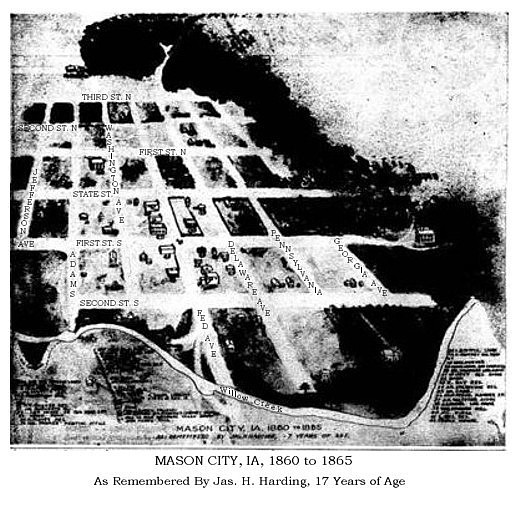
IT TOOK MANY MILLION YEARS [Section 7, Page 3] It was in the early autumn of 1853. Two men stopped their horses about where the Northwestern States Portland Cement Company viaduct now spans North Federal. They looked eastward down the treelined slope of Calmus Creek toward the Winnebago River. "We'll build here, Jim," said the older of the two, 29-year-old John L. McMillin, to his youthful companion, James Jenkinson. The two had driven out from Rockford, Ill., to look over once again the country that McMillin, the trader, had toured the year before in a peddler's wagon. They decided the area between the forks of the two streams, the Winnebago and Willow Creek, was an ideal site for a town.
With axes and saws they built a cabin, 12 by 14 feet, of logs from surrounding trees. That cabin was the first white man's habitation in what was to become a city of 30,000. Directly south of them three other men - John B. Long, George Brentner and Joseph Hewitt - had laid out a street and lots for a town. They called it Shibboleth, the old Biblical password. Later it was named Masonic Grove, then Masonville, and finally, Mason City. Each of the three men owned one third interest in the plat, although the land on which it was laid out still belonged to the government. Later Hewitt sold out his interest and confined his real estate operations to Clear Lake, where he and James Dickirson had established the first settlement in Cerro Gordo County two years before. It was in the summer of 1851 that Hewitt and Dickirson came west from Clayton County to capture buffalo calves and elk, which were known to exist here in great numbers. They first camped on the southeast shore of Clear Lake. When the spring of 1852 arrived the two decided to make Clear Lake their permanent home. Long and Brentner decided to stay and in the next few years were to play major roles in the drama of the prairie that began to unfold on the spot they first named Shibboleth. McMillin, Long and Brentner had a vast expanse of prairie from which to choose. Around them in all directions, stretched an almost flat, gently rolling country, an unending panorama, covered with a deep growth of grass, which in low places was over waist high.
The area at the fork of the streams was covered with a heavy growth of hazel brush, surrounded by trees, mostly oak. Out over the prairies violets, daisies, bluebells and other flowers grew in profusion. Here and there along the line of the horizon could be seen groves of oak, maple, hackberry and linden trees. These first settlers had before them a sight not to be seen anywhere else in the world. Man had viewed the steppes, the desert, the pampas and llanos, but no such prairie as he saw in Iowa. McMillin knew he had selected a good spot. The streams offered opportunities for mill sites. Trees were abundant for building. The land was productive. But how choice a selection he made, McMillin couldn't know. There was no way of ascertaining then where the main routes of transportation would run, what hidden resources lay beneath his feet. He couldn't know that under the soil he recognized to be so fertile lay deposits that were to become the basis of a great construction materials industry and the largest city in North Central Iowa. John McMillin, starting to build then, had no idea that the real building of Mason City started many million years ago, a story that can now be read by geologists in the rock strata. Many things happened in those millions of years to shape the destiny of Mason City. At least three giant glaciers, many hundreds feet thick, passed over the site of the future city and surrounding area.
To the west of Mason City a fourth glacier pushed its way into Central Iowa, leaving a moraine of ridges and embankments in the west tier of townships in Cerro Gordo County. It is because of this moraine that we have Clear Lake and Pilot Knob.
The glacier did something special for the Mason City vicinity. It left large deposits of gravel and, together with the work of preceding ages, deposited 40 feet of yellow and blue clay. Both are a part of Mason City's building material industry. When one of these glaciers retreated with the melting of the ice, it left a deposit that choked up the Winnebago River north of Mason City, with the result that the stream cut another channel southeastward, getting back into the old bed east of the city. In the following period of ice the original stream channel was reopened and the river came back into its old bed.This former river bed lies just north of the McGowans and the Ideal Sand and Gravel Company plant northeast of Mason City. In the pre-glacial period the Winnebago River was one of the most important streams of North Iowa. The last glacier, however, changed that. The big field of ice split the watershed, creating the Shell Rock River, which crosses the northeast corner of Cerro Gordo County, giving it a sizable part of the drainage area of the Winnebago. That the Shell Rock is a much younger stream is evident from the fact that it has formed no extensive valley and has not cut deep into the rock. Changing the courses of rivers or even the watersheds of huge areas was easy work for the glaciers. Before a glacier changed it, much of the Missouri River valley flowed into the Hudson Bay. The Mississippi once flowed west of Mason City and Waterloo and just east of Des Moines, joining the Des Moines River a short distance below Ottumwa and reaching its present channel at Keokuk. But the stage had been set for big developments in Mason City even before the glaciers - in fact from the time this was the bottom of the sea. Geologists have found that time and time again during many millions of years Iowa land was lifted up from the sea and then submerged again. It was at the bottom of these seas that the rock was formed that became the basis for the limestone, shales and clay that underlay the soil in this area. Multitudes of tiny marine organisms with their shells made of lime lived in the warm sea water. As they died their shells sank to the bottom and accumulated in thick beds. Through the ages these shells of calcium carbonate hardened into limestone rock. Such deposits are evident throughout northeast Iowa, cropping out along the banks of streams. While most of this limestone has too much magnesium for cement making purposes, by some strange alchemy of the ages, there was formed along the northern border of Mason City, in fact under the cabin that McMillin built and the surrounding vicinity, rich deposits of a limestone that is almost pure calcium carbonate. This deposit and the adjoining clay were to form the basis of a great cement industry. Other limestone, found in abundance here, proved an excellent building material and was used extensively for that purpose. Limestone also came into use in the process of beet sugar refining. Thus did nature in the geological ages of the past fashion the future of the place chosen by these first settlers in Mason City. Written into the rocks and the clays underneath were the prophecies of great industrial development. Then there is the story of how there came to be formed the deep-layer of Iowa soil. It took centuries to transform the raw mass of gravel, sand and mosses into fertile soil. Wind, rain and frost did their part, but most important of all was the start of plant life in the form of lichens which grew on the solid rock. The accumulation of this organic material made Iowa's rich soil, the priceless heritage of all Iowans.
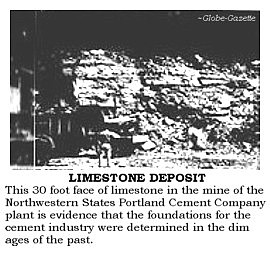
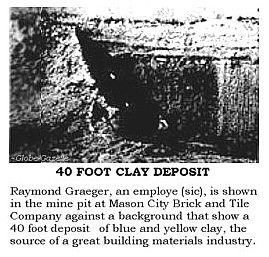
NOTE:
James Jenkinson was born in England on May 10, 1833, served as a Corporal with Company B, 32nd Iowa Volunteer
Infantry during the Civil War, and died in Mason City March 15, 1893. His wife, Mary Jane (Ragan) Jenkinson, was
born in Joliet, Illinois on December 6, 1839, and died in Indiana on July 15, 1903. They were interred at Elmwood-St.
Joseph Cemetery.
A CENTURY of POSTMASTERS [Section 7, Page 2] Twenty-eight persons served Mason City as postmaster [to 1954] since the postoffice was established here in 1855. Following are the postmasters and the dates they served:
DISPOSSESSION of the RED MAN
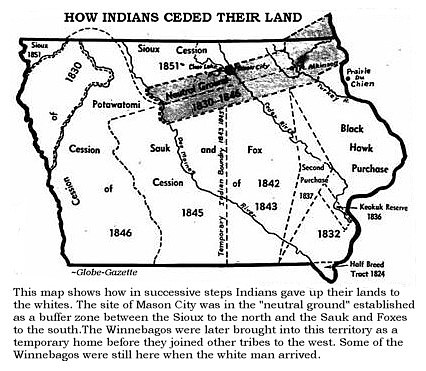
[Section 7, Page 3] When McMillin and other settlers moved into Northern Iowa they came hard on the heels of the departing red man, who had roamed these prairies for unknown centuries, living on buffalo, elk, deer, and other game. Only two years before - in 1851 - had the government gained title to the last strip of Iowa land. This strip which lay along the northern border of the state, including [the] north part of Cerro Gordo County, was acquired from the Sioux, who followed other tribes on the sad trails westward. The first settlers, completely isolated, without wire communications, beyond the reach of hospitals or physicians, 70 miles from the nearest postoffice, were also to live for years in fear of the Indian. The Sioux, incensed because the government failed to live up to treaty obligations, continued to make trouble until he was ultimately subdued after he wiped out Gen. Custer's expedition on the Little Big Horn in 1876. The settlers in Mason City came to live on the old battle ground between Indian tribes, a strip of land which was later made into a buffer zone between the warring Sioux to the north and Sauk and Foxes to the south. It was when this zone was vacated by the Indian that the pioneers first moved into the Mason City territory. So relentless was the white man's pressure westward that it took less than 20 years to extinguish the Indian title to all Iowa land. Ahead of the settlers there was established two separate claims of title to the land, the Indian title from occupants of the land and the European or white man's title. From the time Father Jacques Marquette and Louis Joliet in 1673 first gazed upon the beauties of McGregor Heights as they came down the Mississippi, France had for the most part held that European title. Formal possession was taken in 1682 when La Salle did what Marquette and Joliet failed to do, reached the mouth of the Mississippi. He proclaimed the whole Mississippi valley as part of the domain of his majesty of Louis XIV of France. In all history there probably had never been the equal to that episode when the feeble voice of one man gained possession of so much territory. In 1762 the Mississippi valley land west of the river was ceded to Spain. In 1800 the title went back to France. In 1803, Napoleon, caught in a squeeze in his battle for empire, sold it to the United States for 2 1/2 cents an acre, a real estate deal known as the Louisiana Purchase. At the time the United States acquired the European title, Indians occupied the land on both sides of the Mississippi. The Sauks and Foxes claimed the land east of the river from Wisconsin to the Illinois Rivers and on the west side from the Upper Iowa River south to the Missouri River. A year after the Louisiana Purchase, government representatives at St. Louis got five Sauk chiefs to cede all their lands east of the Mississippi - a total of 50 million acres - for $1,000 a year for an unspecified number of years. Realizing that his people had fallen prey to the white man's trickery, Chief Black Hawk remonstrated against the treaty in brilliant oratory and in bloody encounters with the whites. When the Sauks and Foxes were ordered west of the Mississippi in 1832 this chief led a revolt in what became the Black Hawk War. The heroic old chief was defeated and captured, being place in the custody of a young lieutenant, Jefferson Davis (later president of the Confederacy) at Fort Crawford (Prairie du Chein), who for a time operated a lumber mill near McGregor. Fort Crawford at Prairie du Chien, built in 1816, was one of several forts erected by the government along the east side of the Mississippi to handle Indian affairs. As such Fort Crawford became the first point of contact with the Indian of North Iowa and the white traders to whom he sought to sell his furs. From Fort Crawford efforts were also made to settle the feud between warring tribes in Iowa. No sooner were the Sauks and Foxes established in their new land west of the Mississippi when the United States government instituted a series of treaties for their Iowa holdings. On Aug. 19, 1825, a treaty was concluded by the Indian commissioners, Clark and Cass, with several tribes including the Sauks, Foxes, Potawatomi (sic), Winnebagos, Sioux and others, fixing the boundary lines of lands belonging to each tribe. Transcending all others was one dividing the possessions of the Sioux in North Iowa from those of the Sauks and Foxes, which covered the greater part of the state. A line was drawn by the government from the north fork of the Des Moines River (Humboldt County) to the Mississippi at the present northeast corner of Iowa. Five years later each tribe ceded a 20 mile strip of territory along this line, forming a "neutral ground" where all could hunt but not fight. All of Cerro Gordo County except the north tier of townships was in this "neutral ground." Mason City was thus a part of this buffer zone. In 1849 a total of 2,000 wandering Winnebago Indians were moved out from Wisconsin across the Mississippi, at Prairie du Chien intao this neutral zone in conformity with a treaty made in 1832. Fort Atkinson was built and occupied by federal troops to protect the Winnebagos from the Sauks and Foxes, as well as the Sioux. A military road, the first constructed highway in North Iowa, was built from McGregor to Fort Atkinson. Near the fort a school was erected for the Indians. Several hundred acres of land were placed in cultivation in an effort to teach the red man how to farm. In 1846 the Winnebagos ceded their holdings to the United States and were moved out of the "neutral ground" and into Minnesota the early part of 1848. The Winnebagos are now [1953] on a reservation in northeast Nebraska. A few are still at Winnebago Lake, Wis., and others are to be found here and there on their old stamping [stomping?] grounds. Meanwhile the Indians were pushed westward in the remainder of the state. The Sauks and Foxes ceded a 50 mile strip along the Mississippi at the conclusion of the Black Hawk War. Five years later, in 1837, the second purchase was concluded and by 1842 the Sauk and Foxes had sold all their Iowa holdings, vacating part of it in 1842 and the remainder by 1845, when they were moved to Kansas. Later a few of them drifted back into Iowa and were given land at Tama. By 1851, other tribes, including the fighting Sioux, were out of the state. The sad story of dispossession in Iowa was over. The surveying of land proceeded rapidly as settlers moved in by the thousands. As population increased the status of Iowa changed rapidly. Starting as part of the Louisiana Purchase, Iowa became in succession part of the Louisiana Territory, 1812; the Missouri Territory, 1821; part of the unorganized territory of the United States in 1934; and the Wisconsin Territory, 1836. In 1838 Iowa was made a territory and in 1846 it was admitted to the union as a state. On Jan. 15, 1851, the third General Assembly, meeting in Iowa City, carved out the western and northern part of the state into unorganized or "paper" counties. Cerro Gordo was one of them, being named after the battle of Cerro Gordo in the Mexican War, where Gen. Winfield Scott's soldiers (among them Iowa troops) defeated the Mexicans. Thus was the stage set for the beginning of Mason City in 1853. The history of Mason City in the century that followed paralleled in many respects the history of the nation. With rapid growth of population came a dynamic development in all fields of activity that was to revolutionize our way of living, bringing more changes in 100 years than the world had seen in the previous 100 centuries. The early settlers of Mason City brought with them the necessary character for success, tremendous hardihood, courage and ambition and a great faith in their own strength. These qualities were to be felt in the community for many decades.
BIBLIOGRAPHY
[Section 7, Page 3]
THE RED MAN STRIKES BACK 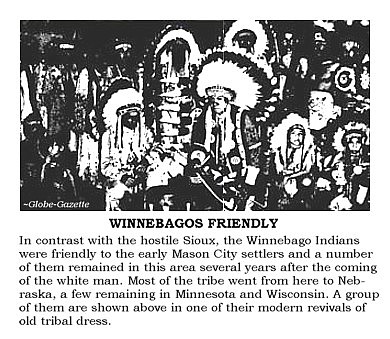
[Section 7, Page 4] With the footprints of the Indian moccasin so fresh in the North Iowa
soil, it was to be expected that the first settlers would have encounters with the red man - both friendly and terrifying. The Winnebagos, mostly friendly, continued to linger in small groups in their old home area. The Sioux, still stinging from past injustices and eager for retaliation, was hostile to both the white man and the Winnebago. It was in this setting that the white man arrived in Mason City. He was to experience the friendliness of the Winnebago and for several years fear the nearby presence of the Sioux. It was a Winnebago brave who staved off starvation for James Jenkinson as the youth, a native of England and unused to pioneer ruggedness, who spent the winter of 1853-54 in the small crude cabin he and McMillin built. Alone in the snowbound cabin, Jenkinson, as far as known, had no contact with other isolated settlers in the county. James Dickirson and Joseph Hewitt were at Clear Lake, where they had come for the first time in 1851. They were joined in the summer of 1853 by Robert O. and James Sirrine, who settled on the east shore of the lake, and by Michael Callanan on the south side. Elijah Wiltfong built a cabin at Rock Falls and two brothers, David and Edwin Wright, lived on the banks of the Winnebago above Mason City. John Biford, who came west with John B. Long from Winnebago County, Ill., joined with the latter in making claims to land in the vicinity of Mason City in 1853. The summer of 1953 also saw Anson C. Owen locate a claim in a grove southeast of Mason City, which became known as Owen's Grove.
NOTE: James S. Sirrine was born February 10, 1811, Peekskill, New York, and died February 22, 1894, Clear Lake. His wife,
Susan C. (Reese) Sirrine, was born in New York on February 25, 1814, and died December 4, 1859, Clear Lake. They
were interred at Clear Lake Cemetery.
In 1853 John Russell came to Cerro Gordo County and two years later moved his family to a farm in Lime Creek Township, which later was sold to the Lehigh Portland Cement Company. He walked to Des Moines to file land claims for himself and others, carrying $4,000. The houses between here and Des Moines were scattered and Russell spent some of the nights sleeping in brushwood, a typical experience for the sturdy pioneers. John J. Russell, his son, served in the Civil War [Co. M, 7th Iowa Cavalry]. The latter's children include the Russell sisters living at 441 East State. NOTE: John Russell was born in 1814, and died August 27, 1895. John J. Russell was born November 5,1838, and died October 3, 1911. They were interred at Elmwood-St. Joseph Cemetery. While the earliest comers established claims on unsurveyed lands, 1853 saw the surveying of the county completed. County auditor records show the township and section lines involving Mason City were run by John D. Everett, a surveyor, on Aug. 17, 1853, and the quarter section lines in October of that year by Samuel W. Durham. The spring of 1854 saw the return of McMillian, with his wife, two sons, James and John, and infant daughter, Margaret, born the fall before [1853 in Rockford, Illinois], the first baby to live in Mason City. Also returning with families were George Brentner with John Long, who with the withdrawal of Hewitt from their partnership, claimed title to the town site. Jarvis Rogers arrived with his family and built a cabin 13 miles southeast of Masonic Grove.
Most of the pioneers came to farm, bringing with them cattle, hogs, horses, sheep and domestic fowl, the seeds for cereal, root and forage crops, as well as implements. Rare accounts of their experiences have come down to us from these men and women who dared the uncertainties of the wilderness. The following by Timothy H. Parker leaves a vivid impression of what they early comers had to contend with: "I left Wabash Township, Jay County, Ind., Sept. 10, 1855, with two teams, to come to Iowa. We were 5 weeks getting 10 miles west of Dubuque. It got very cold and as I had no claim picked out in Cerro Gordo County, the place toward which I was making, I concluded to leave my family and go ahead alone to find a location. So I rented a house, got my family comfortably domiciled and came to Mason City, purchasing the farm on which I now live. "I then returned to my family, and in the following April started to my land in Cerro Gordo County. When I got to the Shell Rock River, the ice was running and we couldn't cross with the wagons, so I got Enoch Wiltfong to help swim the horses over and take the family, beds, stoves, etc., across, giving him one dollar for his trouble. After paying Wiltfong I had 30 cents left to begin the summer. "One day, in 1856, we were visited by an Indian squaw, who wanted to trade us her papoose for a bushel of potatoes, because the little thing was sick, and she didn't want to take care of it, but we didn't care about dealing in that kind of goods, and so didn't make a trade."
Among the uncertainties faced by the first settlers in the Mason City area was that of obtaining title to the land on which they had built their cabins. To procure this it was necessary to journey long distances and attend public auctions. To such a land sale in Des Moines went a small group of Cerro Gordo residents Sept. 4, 1854, carrying with them what small amounts of cash they had or were able to obtain from loan sharks. In force at that time was the prexemption act of1841, providing that a head of a family or a single person over 21 could obtain title to 160 acres, provided he build a house on the land and make adequate proof of settlement. He had to swear that he had received no such grant previously, that he did not own 320 acres in any other state or territory, that his intention was not to sell the land. He was then allowed to buy the claim at the appraised value, $1.25 an acre, provided there were no bidders against him. The small band of Cerro Gordo residents who had learned from stony settlers farther east how to proceed, banded themselves together to protect their claims with implied threats against anyone daring to raise the bid. Any further efforts to procure a higher bid was met with stony silence. Yet this $1.25, little as it seems today, was a burden. Succeeding generations will probably never know the real character of the struggle to procure the necessary cash or appreciate the crushing weight of exorbitant interest rates. Land offices were established generally, for the convenience of the settlers. Northeast Iowa was first served by Dubuque, where a land office opened in 1838. The Des Moines office was opened in 1852. To serve settlers in this area a land office was opened in Decorah March 3, 1855, and to that community went a number of the first comers in Cerro Gordo County, standing in line, waiting their turn, sometimes for many hours. In July, 1956, the land office was moved to Osage by land agents who were promised half interest in the town site and as much adjoining land as they desired. In Osage, as in Decorah, the eagerness of buyers caused them to stand in line, sometimes through the night. Some took the doubtful precaution of pouring alcohol into their boots to prevent their feet from freezing. Others thought the alcohol would be more effective taken internally. It was Hewitt's friendship for the Winnebagos that set the stage for the first Indian scare of 1854.He had dealt with the Winnebagos as a trader years before in Clayton County and members of the tribe continued to linger at Clear Lake, enjoying the "pagainena" made available to them illegally by traders to the east. In the summer of 1854 two Winnebago families were encamped near the Hewitt home. One day two Sioux shot and killed a 15 year old Winnebago boy, who was hunting for Hewitt's cows. Alarmed at this show of hostility, the Winnebagos sought Hewitt's help. Hewitt loaded the Indian families into a covered wagon and had them taken to a government camp at Davenport. Another man was sent on a horse to warn the settlers in Mason City. In Mason City the rider got a fresh horse and went on to warn others in the vicinity. Families were placed in wagons and taken to the settlement at Marble Rock while the men stood guard. Meanwhile the families at Clear Lake gathered at the Dickirson cabin, where they waited for the Sioux to depart. After waiting 3 days they spotted 30 Sioux riding back and forth in front of the cabin brandishing their rifles. Hewitt decided to go out and talk to them and asked them what they wanted. The Indians demanded the Winnebago families. The Winnebagos had gone several days ago, he told them. When they refused to believe him he suggested they stack their rifles outside and search the cabin. The red men left their rifles outside and ransacked the house. Then as they left they jeeringly raised their blankets to display other weapons they had on them. They then mounted their horses and rode away. The settlers had no further serious trouble with the Indians until a year later when one morning 11 Sioux in war regalia were discovered waging war on the Dickirson chickens. One Indian had hold of a rooster and was clubbing it to death when Dickirson came around the corner of the house to see what the commotion was. He saw another Indian picking up a small grindstone and starting away. Dickirson caught the Indian, gave him a jerk that threw him to the ground and marched back toward the house with the grindstone. The redskin started throwing sticks from the woodpile, cocked his gun and threatened to shoot. Whereupon the exasperated Dickirson heaved the grindstone on the man and dashed for the house. The Indians then demanded that Dirkirson pay the wounded man $100 or give him a horse. His wife, fearing the consequences, begged him to comply with their demands. Finally Mrs. Dickirson gave them what money she had in the house, $6, some bed quilts and other articles. This pacified the Indians and they left without further trouble. News of this incident, which went down in history as "The Grindstone War," soon spread over the entire settlement. The next morning all the men around the lake, with a number from Mason City, assembled and organized under the leadership of John Long of Mason City. The men rode north toward the Winnebago River until they came insight of the Sioux tepees. They found the camp deserted except for the women and children. Hewitt told them that the white man, Dickirson, was angry with the Sioux braves and would kill them. Just then the Sioux braves could be seen coming from a hunt. The whites went out to meet them. Almost within gun shot the chief advanced with at flag of truce in one hand and a great pipe in the other. Long advanced to meet them and was told the red man desired no trouble with the white settlers. To this Long replied that the settlers had always fed the passing Indian and treated him kindly, although the Indian had frequently been guilty of bad conduct and that they now were determined to endure his insolence no longer. He then demanded that the articles and money given by Mrs. Dickirson be returned and that the Indians should forthwith leave that part of the country. History record that from that day to this no hostile Sioux crossed the boundary of Cerro Gordo County. The Sioux trail of blood and retaliation was to continue leading westward. In 1857 a maddened band of the tribe massacred the whole settlement - 32 persons at Okobokji (the Spirit Lake Massacre). The bloody course led westward to the banks of the Little Big Horn in Montana, where Gen. Custer and his 7th mounted troops were wiped out in 1876.
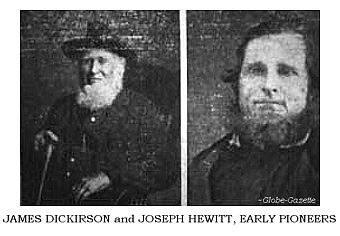
THEY WERE GIANTS IN THE EARTH
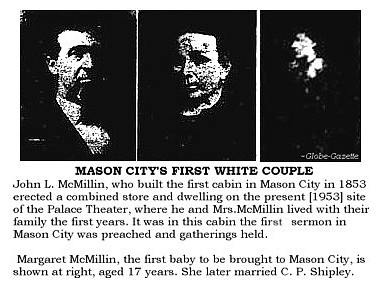
[Section 7, Page 5] "Can you put me up for the night?" At the door of the log cabin of the John L. McMillin family - a cabin that served as living quarters, store and lodging house - stood Elisha Randall. It was in the dusk of the evening of April 16, 1855. "I'm looking for a site in which to build a saw and grist mill," confided Randall as he and the McMillins became better acquainted. The McMillins by this time had moved from the tiny cabin in which Jenkinson had spent the first winter. They now lived in a log house 16 by 18 feet, which had two rooms and a loft. It stood on what is now 110 S. Federal (present [1953] site of the Palace Theater). Here McMillin opened the first store in the county. Joining him were a group of men interested in building an urban community, dynamic individuals who made Mason City a trading center for a wide area, setting the pace for years to follow. They provided leadership for political battles and giant civic undertakings. These giants in the earth included McMillin, Elisha Randall, John B. Long and George Brentner. Because of these men Mason City's pre-eminence as a manufacturing and distributing center started with the erection of the first log cabins along Federal Avenue in 1854 and 1855. Settlers were flocking in. A population count in 1856 showed 652 residents in the county. By 1857 all the choice land had been taken and on July 6, 1859, the land office at Osage was discontinued as practically all the land in North Central Iowa had been acquired. In the flow of newcomers were business and professional men to join McMillin, whose store was for a brief time the one trading post for a wide area. Here the settler purchased from the limited stock of molasses, brown sugar, tea, coffee, tobacco, candy, salt fish and salt, as well as denims, calicoes, and other "factory" cloth, a little glassware, crockery, powder and lead, as well as boots and shoes. There was little money in the community. People were economical and self-denying. Only the necessities and a few comforts were in demand. It was a modest beginning for the giant supermarkets and department stores of today. Besides serving as a store and inn the McMillin cabin was the community gathering place. There the first sermon in Mason City was preached and there the first election held. Other business establishments followed. Stackhouse and Belt opened a grocery store in a log cabin - a sort of combination store and eating place. Crackers, cookies, ginger bread, cheese and smoke herring were among the staple articles sold. Thomas Drummond and A. B. Miller opened a law and real estate office. Mark Dexter started a wagonshop. James Stewart started a photograph gallery and in 1856 when James Church built a small hotel this was operated by Stewart. Solomon Zuver had a tavern on the north bank of Willow Creek.
So rapidly was the town growing that Editor Coon in his Jan. 13, 1859 issue ran six columns on the history and advantages of Cerro Gordo County, stating Mason City then had two hotels, the Waukonza and Solomon Zuver's, three grocery and dry goods stores, a mill, two carpenter and joiner shops, a wagon shop, a tailor shop and a blacksmith shop. The next year John F. Taylor began the sale of farm implements and in 1862 W. H. Harding started selling furniture. In 1864 D. J. Farrell began working as a mason contractor in stonework and Miss S. E. Hartshorn operated the first millinery shop.
NOTE: Margaret A. McMillin, born in Rockford, Illinois in 1853, married Clinton Pardes Shipley,
a printer, on November 17, 1875. They built the Shipley House, a.k.a. Kenneth Schultheis House, in 1913, which was placed
on the National Register of Historic Places January 28, 1980. Clinton died in 1936; Margaret died in 1940; they
were interred at Elmwood-St. Joseph Cemetery.
In 1865 Martin Baumgartner opened a new hotel, the Commercial House, and Martin Vermilya started the first lumber yard. S. B. Waughtal opened a blacksmith shop in 1866, hauling coal from Waverly at $50 a ton. In 1867 J. A. Farrell and J. H. Valentine established a tinshop and Burr P. Kirk, a livery stable. After moving to larger quarters McMillin sold his log building to Robert Clark and John Long who rented it to Horace Green, who converted it into a hotel. Several rooms were added and the house became known as the Waakonsa and later the Eureka. Some years later when the building was torn down to give way to more modern structures, a newspaper reminisced thus: "In this old time parlor the celebrities of northern Iowa, who came for business or pleasure, were accustomed to elevate their feet, drink toddy and smoke dark clay pipes. If the old logs in that landmark could speak and reason, they would unfold a tale that would be rich with frontier incidents. "Among the noted guests who ate hash at the Wauknoza and are so well remembered by old settlers here are: Judge Porter and ex-Gov. Eastman, of Eldora; W. N. Davidson and D. W. Dows, of Hampton; Judge McFalan, of Boonesboro; Judge Fairfield and J. G. Patterson, of Charles City; Timber Wood, of Waverly; and W. P. Hepburn, of Clarinda, with scores of others who came here to attend court. "Those days of rollicking good times all came crowding upon the mind, as the old settlers gazed upon the sturdy building as it was being torn down under the blows of the advancing ax-man." McMillin occupied a unique place in the history of the community. Not only was he the first settler, but his descendants continued to live here and are now in the fifth generation. His family thus spanned the 100 years of the city's history. McMillin, himself, meeting reserves in the harsh pioneer years, gave up his extensive holdings and moved to Motley, Minn., in 1878, to begin life anew as a pioneer. There he died in 1885. NOTE: Mr. and Mrs. John McMillin were
charter members of the First Methodist Episcopal Church at Motley, Minnesota, organized in 1882. SOURCE: Fuller, Clara K. "History
of Morrison and Todd Counties, Minnesota, Their People, Industries and Institutions." Vol. I. p. 116. B.E. Bowen & Co., Inc. 1915.
"I drove into this town, then called Masonic Grove, and put up at the only house in town at that time, the home of John L. McMillin and his family. The family consisted of McMillin and his wife, James John and a little girl, Maggie, then about two years old. "At that time there was no other house on main street. Dr. Silas Card of Vinton had been here and put up a log house, all except the rafters. This was used afterwards as a boarding house. I was here to hunt up water power for a saw mill. "I came by invitation to see and locate a site on Lime Creek for a saw mill. The offer was made to give the mill site and three acres of land by John B. Long and George Brentner,owners at that time of most of the land bordering on Lime Creek (Winnebago River)." The mill stood near the present site of the Jacob E. Decker and Sons plant. The mill building was 26 by 60 feet and stood on walls built of stone, lime and mortar three feet thick. In order to get the lime Randall had to build a lime kiln, which in itself became a flourishing industry. He went to Rock Island to purchase the machinery and there got three masons to build the foundation. Randall who brought his family here June 8, 1855, started the mill Oct. 8 of that year, sawing the first board every cut by water power in the county. Farmers and village dwellers alike rushed logs to the mill and 60,000 feet were cut before the stream froze over in December. The Winnebago River, despite the removal of a large part of its watershed by glacial action ages ago, had ample water for the mill. The following spring the swollen waters from thawing of heavy snows carried the mill away. The rebuilding of the plant was an all-community event. A grist mill was added, providing corn meal, a popular food with the pioneers. Later the mill was enlarged and in 1875 it was rebuilt and new machinery installed for the manufacturing of flour. It 1876 Randall sold the mill to John T. Elder and later it was acquired by the Kuppinger family. Elisha Randall, Mason City's first industrialist, had other achievements to his credit. To facilitate his lime burning operations in 1872 he patented what was known as Randall's Perpetual Lime Kiln. This process was adopted in many parts of the country. Randall descendants continued to live in Mason City and are now in the fifth generation. Mrs. Willis C. G. Bagley, wife of the former president of the First National Bank, is his granddaughter. NOTE:
Elisha Randall, Jr. was born September 22, 1818, Brookfield, New York, worked in his father's mills, established his
own mill in Edmeston, New York in 1844, located with his family in 1854 at Waterloo, Iowa before arriving in Mason City
the following year. He died in 1897. His wife, Lucy M. (York) Randall, was born in 1821, and died in 1913. They were
interred at Elmwood-St. Joseph Cemetery. SOURCE: Wheeler, J. H., ed. "History of Cerro Gordo County, Iowa."
Lewis Pub. Co. Chicago. 1910.
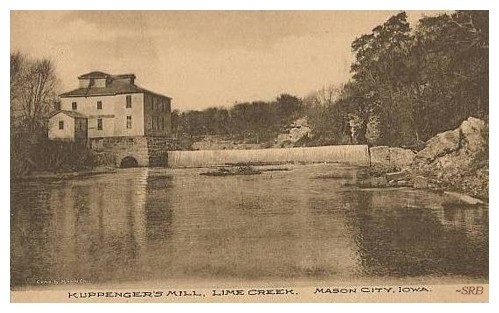
For many years the lime industry was the most important in the city. Connected with the quarrying of the native stone, it provided the first impetus to the building materials industry that was to expand to gigantic proportions. The winter of 1855-56 that preceded the flooding out of Randall's mill was one of the worst in the memory of early settlers. Several farmers, caught in the terrible blizzard on Dec. 22, 1855, froze to death. On that morning A. J. Abbott and Charles Wicks of Portland Township went to Geneseo Township with three yoke of oxen to obtain logs for a stable. While they were in the timber the storm broke. They started for home, but lost their way and finally abandoned their cattle and sled and started walking. Three days later the bodies of the men were found. Others had a like fate. The winter of 1856-57 was also reported to be indescribably terrible, the blizzards coming up treacherously, the drifts on the level country reaching 9 feet in depth. Twenty-two persons in Cerro Gordo County were frozen to death and the loss of stock to farmers was appalling. It was in this blizzard that two boys, Walter and Reuben Williams almost perished while caring for cattle west of Mason City on Willow Creek. On the morning of Dec. 28, 1856, they were watering the cattle when the storm burst upon them without warning. They battled for hours to care for the stock and finally took refuge in a grove of trees and then tried to reach home. They spent the night wandering about to keep awake and to keep from freezing By morning they were within calling distance of a house in Mason City, although they had been lost through the night. They were badly frozen but survived. The story of their experiences was written up in the Palimpsest. The story of the two others in the big four of Mason City's early beginning - John B. Long and George Brentner - will be told in the next chapter. NOTE: A. J. Abbot died December 22, 1855. Interment was made at Owens Grove Cemetery, later re-interred at Elmwood-St. Joseph Cemetery. Charles Wicks died December 22, 1855, interment was made at Owens Grove Cemetery.
THE COUNTY SEAT FIGHT
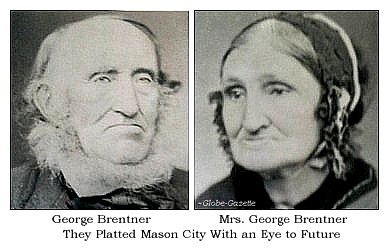
The two men with their wives, Anna Long and Julian Brentner, set aside a "public square" (Central Park) for the people of Mason City. There was no stipulation connected with this site. On the other hand "block 26," present [1953] site of the school administration building, was given to the people of the county on condition that a courthouse be erected on the site. It was an inducement to get the county seat for Mason City. The two families divided the town sites between them, Brentner taking those west of Federal and Long, east of Federal. The unschooled Brentner, who had come to America as a stowaway from Germany, had arrived in Mason City with a pocket full of nuggets from the gold fields of California. He sought the partnership of the educated Long in the platting of the new town. The plat was prepared June 28 and 29, 1855, and surveyed by Irvin W. Clark, county surveyor. The instrument was acknowledged before John L. McMillin, justice of the peace of Cerro Gordo County, Aug. 31, 1855, filed on the following Nov. 9 and recorded in plat book A, pages 2, 3, 4, and 5. On this plat the present Federal avenue was called St. John's; Washington was Solomon street; Adams, Clark street; and Jefferson, Wall street. State street was designated the main east and west thoroughfare and is the only street that still carries the original name. As the reproduction on this page shows, the plat extended from what is now 2nd south, to 4th north, west to Jefferson and east along State to Georgia. Meanwhile McMillin and Long assumed the leadership in the organization of the county. At that time the state law provided that any unorganized county could petition the county judge of the nearest county and be attached thereto as a civil township. In response to such a petition John M. Hunt, Floyd County judge, called for an election to be held at the McMillin store the first Monday in April, 1855. At this election McMillin and George L. Bunce were elected justices of peace. Shortly afterwards a petition for organization of the county of Cerro Gordo was presented to the Floyd county judge. The petition was granted and an order issued for the election of county officers Aug. 7, 1855. McMillin and Long called a convention at the McMillin store for nominations. Fifty-four voters cast their ballots at this election, also held at the McMillin cabin store, electing Long, county judge; Henry Martin, clerk of court; C. B. Raymond, prosecuting attorney; Henry Van Potter, treasurer and recorder; David Wright, school fund commissioner; I. W. Card, surveyor; N[athan]. W. Stackhouse, sheriff; and James Dickirson, the first settler in the county, coroner. All except Henry Martin were democrats. Shortly after this election Judge Samuel Murdock of the district court, appointed three commissioners to locate the Cerro Gordo county seat. These commissioners, all from Floyd County, decided favorably for Mason City and drove the county seat stake on the previously designated county courthouse square, set aside by Long. This action made residents in the west part of the county indignant and a committee made up of Thomas Drummond, Marcus Tuttle, Silas Card and I. W. Card appeared before the sixth general assembly at Iowa City, which convened in December, 1856, with a petition asking the appointment of three new commissioners to relocate the county seat. They were successful in their efforts and before the close of the session, Stephen H. Henderson, Mitchell County; James Taggert, Benton County; and George McCoy were appointed commissioners to relocate the county seat. This commission met at Clear Lake April 29, 1857, and selected Livonia, a site on the east edge of Clear Lake and in the northwestern corner of section 18 in Lake Township, as the county seat. During the summer of 1857 a courthouse was erected on the new site and late in the fall some of the county records were moved from Mason City to the new county seat, but most county officials were reluctant about moving. On Feb. 1, 1858, the county court convened in Mason City with County Judge J. S. Church presiding. It was immediately adjourned to meet at Livonia, where it convened and began the transaction of business. Among matters before the court was a petition presented by A. B. Miller, asking the judge to set an election in April, 1858, to submit to the voters of the county this question: "Shall the county seat of Cerro Gordo County be removed from Livonia to Mason City?" The election was held, following a heated campaign, with Mason City winning 155 to 48. The county records were brought back to Mason City where they have since remained. The ghosts of this bitterly fought election were to rise again. In 1939 the west part of the county defeated a project to build a new courthouse in Mason City. On Sept. 5, 1855, a postoffice was established here, with the town taking the name of Masonville, with Charles Lutz as the first postmaster. By a happy coincidence, it was discovered that another postoffice in the state had that name, so on Nov. 21, 1855, the name of Mason City was adopted and Lutz again named postmaster. The name, Mason City, preserved the original intent of the first settlers that the town be named after the Masonic Order, of which most of them were members. Records reveal that the notorial seal of John B. Long as judge has inscribed the Masonic emblem. Streets were given Masonic names.
Until the office was established here the nearest postoffice was at Cedar Falls, 70 miles away. As a rule most of the mail was brought by teamsters going to Dubuque for supplies. In 1856 the federal government employed a regular mail carrier, Charles Johnson of Shell Rock, to take the route. To help out his pay, Johnson used an improvised mail coach in which he carried packages and occasional passengers with their baggage. The hardships of pioneer life didn't interfere with social events. Mason City's first grand ball was held in the 856, the occasion being the dedication of the new store building erected by Long. John M. McMillin was the caterer and Mrs. McMillin chief cook and mistress of the dining hall. There were 75 couples and Mrs. McMillin prepared and served supper for some 150 persons. The dances were schottishes, polkas and the waltz, with some quadrilles and reels. The first wedding ceremony had been performed the year before Long as county judge. The contracting parties were William Wilson and Miss Abigail Gardner. The first death was that of Mrs. James Stewart, wife of Mason City's first photographer, who had recently arrived. The first birth was that of a daughter to Mr. and Mrs. Alfonzo Garner. Thus life, with its triumphs and defeats, went on in the new community. But other events of greater importance were in the process. In 1857 over expansion of railroading and other business in the west brought a panic that was felt even in the far inland prairie towns. It was to leave its mark for decades to follow. It cast a dark shadow over the lives of the Mason City pioneers. In 1857 John B. Long and with him George Brentner, gave to Paul Felt a deed for all of what was then Mason City, which had not been sold in lots, for $8,000. Felt replatted the city, enlarging it considerably. In this plat the public square was given for the second time to the city. The block set aside for a courthouse was claimed by Felt for the reason that the county seat was then in Livonia. On his plat, it was designated as "courthouse square." Felt renamed all the streets except State. Federal became Commercial and avenues to the west were named after presidents, in the following order: Washington, Adams, Madison and Jefferson. The avenues to the east were named in the following order: Michigan, Superior, College and Cedar. East and west streets were numbered from the south, starting with 1st on 5th, south, and extending to 6th, north, which was 11th street. On filing his plat of Mason City Sept. 18, 1857, Paul Felt owned, besides all of Mason City, several thousand acres of land in the county. Money was plentiful in the boomtime before the panic bubble burst. He went to Buffalo, N. Y., immediately after the replatting and began negotiations for trading his holdings here for Buffalo property. The deal was reported to involve $50,000. The papers were drawn up ready to sign when the panic struck, bringing with it the closing of many banks. The deal was never concluded. Felt had borrowed money to buy his Mason City holdings. With panic came his financial ruin and the ruin of others who had signed notes for him. Felt's holdings were sold at sheriff's sales to satisfy judgments against him. When Felt, Brentner, Long and others realized what threatened them, they laid plans to stave off the unhappy day. The property was first deeded to George Brentner, then Brentner deeded it to Charles Huntley, who went to the Civil War and was killed in battle. It was not until 1865 that the matter came up for hearing with a great lawsuit that was the talk of the country. The suit was brought against Felt and others by the eastern men who had advanced the money. The court set aside the deeds transferring the town to Brentner and Huntley. So judgments were entered against almost every piece of real estate in Mason City and all were sold at sheriff's sale. Among the properties sold was the "courthouse square," which the school system was to acquire later. But that is another story. Datus Coon established his Cerro Gordo Press (the first newspaper in Cerro Gordo County) in Mason City just in time to print the sad record of the effect of the panic. The press for July 31, 1858, had 14 columns of delinquent taxes with 176 in each column, or 2,464 titles altogehter - most of them under the heading of "owner unknown." Under these circumstances it is no wonder that Long's retail business was closed out by his creditors and that Sheriff N. W. Stackhouse advertised that he would hold a sheriff's sale of the goods at the front door of the house on the 8th of August, 1858.
Thus was crushed the last financial hope of cultured and educated John B. Long, who made such an auspicious beginning and contributed so much to the new community. The pioneers, in conquering the prairie had themselves been humbled. Long left not long afterwards and made his home in Missouri and later Arkansas, but not before being tried by a jury and acquitted on a charge of malfeasance in office. George Brentner, Long's associate, continued to live in Mason City, where his descendants became an important part in the community life.
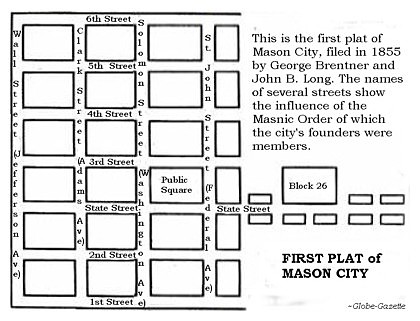
NOTE: George Brentner was born in 1804, Worms, Germany, came to America at the age of 13 years as a stowaway, arrived in
Cerro Gordo County with family member John B. Long from Rockford, Illinois, in 1884, and died at the age of 81 years on
April 9, 1885, Mason City. His wife Julia Ann (Printz) Brentner was born in Virginia April 6, 1806, and died
in Mason City April 3, 1879. They were interred at Elmwood-St. Joseph Cemetery.
COUNTY JUDGE TRIED by JURY
It was Judge Samuel Murdock speaking. He was in Mason City holding the first term of district court in Cerro Gordo County in June, 1857. The trial was one that stirred the countryside. By some queer quirk of fate John B. Long, acknowledged leader of the community - the man who captained the citizens of the country in their march on Indian invaders and the one selected by an almost unanimous vote to the highest office in the county, that of county judge - now stood before a jury of his peers to defend the conduct of his office. Dr. Silas Card and Jacob Van Curen were charging him with malfeasance in office. It was evident Mason City's first settlers demanded a high standard of ethics in government officials. As the case came to trial Long was under suspension from performing his duties as county judge as result of a previous hearing in Floyd County. The case was continued and thus became Cerro Gordo County's first jury trial. The evidence of malfeasance probably wasn't too convincing for the jurors returned to inform the judge they were unable to agree on a verdict. The judge ordered the case continued and that the defendant be reinstated in office. In the following election, August, 1857, Long apparently didn't run for re-election and was succeeded by his attorney, Jarvis Church.
There is nothing in the county court records to indicate with what misconduct Long was charged. Judge Long's minute book is the earliest record of court proceedings in the county. The first item states that a warrant was issued to A. P. Luse & Co., for $458.25 on Dec. 29, 1855, in payment for county books, seals and other materials for the county officers. Judge Long drew a salary of $15.30. On Aug. 8, 1856, James Dickirson, the county coroner, received $6 for holding an inquest over the body of John Van Aiken, who froze to death the previous winter. A warrant was also issued to John McMillin for $4 in consideration of his having been a 'jewry" at the inquest. Sheriff N. W. Stackhouse received $3 for serving and obtaining a jury. Among others who received the first payments of public money were Mark Dexter, $8.75, for making a table for the recorder; James Simpson, services as a deputy surveyor, $6; H. A. Stiles, for assessing Lake Township, $43. These were small payments,but they undoubtedly loomed large in those days when money was scarce. But the county judge's records reveal the settlers had their eyes on bigger things - the great, magical possibility of getting a railroad into Mason City. On Sept. 25, 1856, Judge Long issued a proclamation for an election Oct. 27, 1856, to vote on the question of the county taking $130,000 stock in the McGregor, St. Peter & Missouri Railroad, then considering building a road west from Marquette. The vote was unanimous for the project, the only time in the history of Cerro Gordo County that a vote has been unanimous. At that time the county was divided into three townships, which cast the following vote: Canaan, 45; Lake, 39; and Own, 6, making a total of 90. Mason City was to wait another 13 years for that railroad, in the meantime helping to fight the Civil War. Church, on succeeding Long as judge, redivided the county into townships, increasing the number from three to four. These were named Mason, Falls, Lake and Owen, as shown on the map above.
In the October, 1857, election the question was submitted to the voters of raising the salaries of county officers to $300. It carried by a large majority. The office of county judge, a creature of the 1851 General Assembly, came into being to replace the offices of probate judge and county commissioners. In 1859 the office of county supervisor was created, relieving the county judge of much business. In the winter of 1868-9 the legislature abolished the office of county judge and created that of the county auditor. George E. Frost, then serving as judge, was made ex-officio county auditor until one was elected. Preceding him there had been a number of prominent pioneers in the office, including George Vermilya, who succeeded Church, Marcus Tuttle, Elisha Randall and W. E. Thompson. At the time Judge Murdock held his first term of district court in the county, John Porter was admitted to the practice of law. He was to succeed Judge Murdock on the bench two years later. This term also saw naturalization papers given George Brentner. The first divorce granted separated Frederick Hills and Catherine Hills. At the time of this first term of court Cerro Gordo County was part of the 10th judicial district, which included Clayton County, the home of Judge Murdock. Recognition of districts in 1857 placed this county in the 11th district and on July 4,1864, the 12th judicial district was created. It has continued ever since with the same eight counties: Bremer, Butler, Cerro Gordo, Floyd, Hancock, Mitchell, Winnebago and Worth.
When the legislature in 1869 abolished the county judge office, it turned over the judicial duties of the office to circuit court. Each judicial district was divided into two circuits, over each of which a circuit judge presided. The circuit court had concurrent jurisdiction with the district court in all civil actions and exclusive jurisdiction of all probate matters.
The early years brought a number of attorneys to Mason City. First lawyer to settle here was Thomas Drummond, a Virginian, who formed a partnership with A. B. Miller for the practice of law and to engage in the real estate business. Others to follow were Jarvis Church; John Porter, first Mason Cityan to sit on the district bench; J. W. Murphy; George and B. F. [Benjamin Franklin] Hartshorn, father and son; J. K. Boyd and W. S. Johnson.
A number of honors came to Stanbery. In the spring of 1859 when Mason City was but six years old and the county had a population of 857 a group of Masons decided to organize a Masonic lodge, naming Stanbery the first worshipful master. Benevolence lodge, as it was named, held its first meeting over John L. McMillin's trading post May 8, 1859. But not all the early doctors switched from medicine to the then probably more lucrative practice of law. The first medical practitioner in the county was Dr. Silas Card, who came in 1854. He was followed by Dr. E. D. Huntley in 1856. Outstanding of the prairie years physicians was Dr. A. A. Noyes, who came from Baraboo, Wis., and was the chief organizer of the first medical society in the community. Dr. William Allen and Dr. John J. Odgen also settled here in 1866. While the city's founders had wisely provided a square block for the courthouse, the use of this block for that purpose was never to materialize. By the time the county seat was returned to Mason City, most property, including the "courthouse square" was tied up in a huge receivership suit. The tensions and sacrifices of the Civil War were soon to follow. A feeble expression for building a courthouse is shown in the election records for June, 1858, with 28 for and 7 against the proposition. But it was to be some years later before the county took steps to acquire a courthouse. By this time the governing body of the county had become the board of supervisors. The first board of supervisors in this county met in Mason City Jan. 7, 1861, in the office of the clerk of the board. Elisha Randall, Mason Township, was elected chairman. Others on the board were: A. C. Owen, Owen; J. J. Rogers, Geneseo; John Gardner, Lake; C. W. Tenney, Falls; and John M. Hunt. By that time the county had six townships. At this time the county offices were situated in a stone building erected by Jarvis S. Church on the site of the present [1953] Cecil Theater. By act of the board, the county officers were authorized to rent the portion of the building needed for $200 a year. Later the county purchased the building and enlarged it to fit the needs of the county. It served as the courthouse until the present building was erected in 1900.
Stilson came to Cerro Gordo County in 1856 from Chippewa Falls, Wis., to sell some land he got in a trade. He was unable to sell the land and returned to the pineries of Wisconsin, returning in two years with his wife to live on the land.
SCHOOL BECOMES COMMUNITY CENTER
They built a home, a schoolhouse and then a church. There might have been a trading post, a tavern and a saloon sandwiched in between, but these were subservient to the main cultural currents that dominated the building of the community. Often the schoolhouse served as both school and church.
NOTE: Elizabeth "Lizzie" (Boyton) Thompson was born at Sullivan, New Hampshire, October 6, 1836, and died June 12, 1884, Mason City. Her husband, Adelbert Mason Thompson, was born June 4, 1834, Gilsum, New Hampshire, and died December 7, 1899, Mason City. They were interred at Elmwood-St. Joseph Cemetery. Among the first log cabins in Mason City was one designated as a school. It was there that Mrs. Lizzie Thompson started teaching in 1856, only three years after the first log cabin was built and two years after the first families arrived. It wasn't long after this, however, before the wish of the community for better school facilities expressed itself. On Dec. 25, 1857, the school district acquired a lot at the corner of First and Georgia S. E. and erected a two-story stone school building, 30 by 44 feet, on the present site [1953] of the First Methodist Church. The building cost $3,000. The pioneers were willing to spend money for the education of their children. By 1859 when Mason City's population was 250, the school had 40 pupils. This building became the center of cultural life. Early church organizations held their meetings there. It was to serve as the community school until the erection of the Central School Building in 1872. The second floor served as the "city hall." Until the office of county superintendent was created in 1858 each district operated its schools without supervision, except for the limited powers in the hands of the school fund commissioner, whose duty it was to handle school funds. The commissioner's office was abolished in 1858 and in April of that year John M. Hunt was elected the first Cerro Gordo County superintendent of school. Hunt was succeeded by Dr. W. M. Skinner of Clear Lake. Next in the office was Rev. Thomas Tenney, founder of a number of Congregational Churches in this area. Succeeding him were John M. Brainard, A. B. Tuttle, George P. Griffith and Jarvis S. Church who was elected in 1865. Churches, as did the school, had modest beginnings in Mason City. The first sermon was preached in the McMillin store one Sunday in 1855 by the Rev. Mr. Styles, believed to have been of the United Brethren faith. The service, attended by families from far off sections in the county, was delayed because at the time McMillin found and shot a wolf in his hen house. Elisha Randall, prominent figure in both public and business activities, took the leading role in organizing the first religious group, the Methodists, in Mason City. The congregation was formed March 8, 1857. Until the new school was built, services were held at the McMillin store. The organizers included Mr. and Mrs. Randall and daughter, Mrs. John B. Long, Mrs. George Brentner, Timothy Parker and wife, N. M. Adams and wife and Alfred Taylor and wife. The Methodists started building a church in 1870 and on Nov. 20 of that year the basement for the structure was dedicated. This basement was at that time the largest auditorium in the city and was used for community purposes. When the flat roof fell in, subscriptions were taken to complete the building, which was accomplished in 1872. The church stood at 14 First N. E., present [1953] site of the Piggly Wiggly store. On March 7, 1858, a Congregational Church was organized in Mason City under the direction of Rev. Thomas Tenney of Plymouth, who had held periodic services here since 1855. Among the first members were Nathiel (sic) Adams, Emma Adams, Charles M. Adams, Simon Van Patter, L. L. Huntley, Lucy Temple, Elizabeth Dibble, Jane E. Garner, T. Green and Eleanor Florence. NOTE:
Nathanel M. Adams was born May 6,1814, Auburn, Maine, and died November 11, 1895, Mason City. Emma Ann (Child) Adams,
his wife, was born February 14, 1816, Cambridge, Massachusetts, and died January 24, 1887. They were interred at
Elmwood-St. Joseph Cemetery.
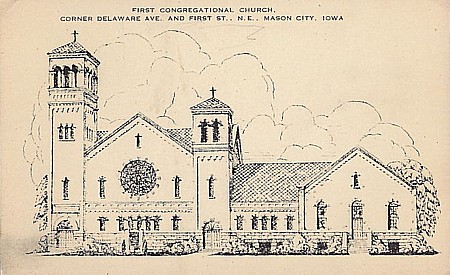
First church to be erected in Mason City is pictured above. It was build by the Congregationalists in 1866 and is still used as parish parlor. Erected later was the parsonage, shown on the corner, where the main structure of the Congregational Church now stands. In April, 1866, a lot was purchased for $30, on which was erected a stone church at a cost of $4,294. The whole amount was raised by subscription except for $500 donated by the Congregational Union. This church, the first to be built in Mason City, was dedicated May 12, 1868. This building is part of the present First Congregational Church, being used as parish parlor. NOTE: A cornerstone for a new and larger church was laid April 27, 1898. The old structure was incorporated into the new building, which was dedicated on December 4, 1898. The congregation voted on January 11, 1861 to become a part of the United Church of Christ, a merger of the Congregational Christian Churches with the German Evangelical and Reformed Church. The third religious group to be organize here was the Catholic Church. That has since become St. Joseph's parish, was formed in 1864. Previous to that time visiting priests or missionaries held occasonial meetings in homes. In 1870 a small wooden church was built at a cost of $2,000 on the present St. Joseph's site under the leadership of Father Feeley of Charles City who came to hold services at irregular intervals. The first trustees were Timonty Dovan, John Griffin and William Uslner. The Baptist Church was organized on Nov. 17, 1866, with 10 members, A. Dunham and wife, John Keller and wife, Mrs. Williams, Mrs. Miller, Harriet Tuttle, Nella Tuttle, Mr. Rennills and wife. Thus the early community had four churches and a school. But other vehicles of culture were also in the making. On July 1, 1858, there came off a crude hand press in Mason City, copies of the Cerro Grordo Press - the first newspaper to be printed in the county. The press and other equipment were brought by Datus E. Coon from Osage, where he had been doing a flourishing business as the land office newspaper. With the discontinuance of the land office Coon moved on to what appeared to be greener pastures. As revealed in an earlier chapter he got to Mason City in time to print many columns of delinquent taxes.
The coming of the newspaper was a tremendous forward step. No longer would it be necessary to get the news of the community by word of mouth at the trading centers. The volume 1, number 1 of the Cerro Gordo Press carried this advertisement for the county's first merchant: "John L. McMillin, Wholesale and Retail Dealer in Staple Dry Goods, W. I. good, groceries, clothing, hats, caps, boots, shoes, hardware, cutlery, crockery, glass and woodenware. Sale rooms on Commercial St." This advertisement appeared for the Waukonza House, "Man and team kept for $1,12 1/2 a night. Board $2.50 a week. Stage leaves this house for the east and west, in which passengers will be carried for 5 cents a mile. The best stable in Mason City will be found at this house." In his "Salutatory" editorial, the editor stated he would print the "news from all parts of the globe." Instead of the elaborate teletype systems of today which flashed the news instantly from anywhere, he relied on the slow, laborious mail coach travel which made all news from the outside weeks late. Despite a transitory existence in Mason City, Coon was a crusader for culture. In the Nov. 18, 1858, issue of his newspaper, he suggested that the number of dancing parties be reduced and that instead each participant donate a small amount regularly for the establishment of a circulating library. The editor was ahead of his day but such a library did come into existence 11 years later. One day in 1859 Coon ran an editorial asking this question: "Why cannot we have a fair? Mitchell County has organized one and Wright County also. What is the matter with Cerro Gordo?" Evidently nothing was the matter for Cerro Gordo Agricultural Society was organized, a fair was set for Oct. 11, 1859, and Elisha Randall, A. Garner, Thomas Tenney, T. O. Howard, F. B. Frisbee, E. A. Tuttle, George Vermilya and E. Osborn incorporated themselves with 20 others as such a body. Fairs were held each year and in March, 1866, the Cerro Gordo Republican announced the 6th fair was to be held Sept. 20 and 21, 1866. At this fair there were 194 exhibits and $211.50 was paid out in premiums. Coon was paid $500 and promised the county printing when he was lured to Mason City to start his paper. After he had been here a year he complained that the county wasn't living up to its agreement and was withholding printing. He stayed two years and then moved his plant to Hancock County where for several years his paper was the official organ for a half dozen counties and where he published enough tax list supplements to carpet every house in the county. After Coon's departure, J. H. Aylesworth, a teacher in the village school, decided to establish a newspaper. In 1861 he went to Chicago and bought a printer's outfit which he moved to Mason City and started the Cerro Gordo Republican. The first issue appeared in April, 1861. On Jan. 1, 1862, the Republican was sold to Horace G. Parker and C. W. Tobin, one of the compositors on the paper. Parker settled originally in Clear Lake in 1855 and was one of the first to hold the joint office of county treasurer and recorder. In 1860 Parker moved to Mason City, where he became active in several enterprises. In 1870 he built a flour mill on Willow Creek (Rock Glen). On Jan. 1, 1863, after Tobin had entered the army, Parker was joined by Silan Noyes as a partner in the newspaper. In 1867 Parker sold out his interests to S. A. Sirrine. In the years to follow, the Republican passed through several hands.
MASON CITY in CIVIL WAR
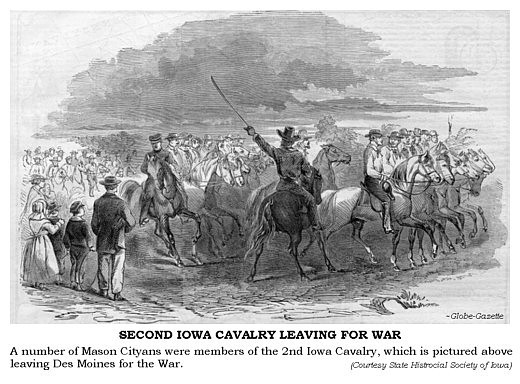
[Section 7, Page 9] "They say Lincoln has been shot. I hope to God it's true and I hope my brother shot him." The bitter words rang out at the Eureka House, where a group gathered to hear the sad news brought by stage relay. The speaker was buxom 17-year-old Mary Ragan, Eureka House employe (sic), and the date was April 18, 1865. In a community that had done its utmost in the Civil war and stunned by the death of the President, Mary Ragan's declaration was like setting a match to a powder barrel. Almost every home had been touched by the grim hand of the struggle in which Mason City took part from the beginning. When the stagecoach first brought the tidings in mid-April, 1861, that the rebels had fired on Fort Sumter and Lincoln was calling for 75,000 volunteers, the excitement spread from cabin to cabin. Datus Coon, immediately dispatched a letter to the governor asking permission to organize the volunteers of Cerro Gordo. With this permission Coon worked to get enlistments and by July 20, 1861 he stood beside his men, six of them drawn up on Main Street. He called the first roll: Daniel Williams, Will E. Tucker, John Van Potter, John Hobbs, L. H. Ferguson. A bugle rang out, the men marched away to join the Second Iowa Cavalry and Mason City was in the war. More were to follow in a steady stream until the number reached 125, one-eighty of the population of the county.
The Cerro Gordo home guards were organized with George Fuller as commanding officer. Fuller was among those who marched away with B Company of the 32nd Iowa the next year and a casualty of the war. When Lincoln issued the call for 600,000 volunteers in the summer of 1861, the supervisors appropriated $100 for each man enlisting in the U. S. Army from Cerro Gordo County and $4 a month to be paid the wife of each volunteer and a $1 a month for each child under 15 of such volunteer. On the President's call for 300,000 more soldiers in December, 1864, the board saw that a draft would follow unless some measure was adopted to obtain more recruits to make up their quota of men and passed this resolution: "Resolved that a bounty of $500 be paid to a sufficient number of volunteers to fill the quota of this county under the present call of 300,000 men," The payments were made in warrants bearing 8 per cent interest. The record reveals, however, that Cerro Gordo was providing more than its quota. During the first two years of the war up to Jan. 1, 1863, the county's quota was 69. Up to that time 86 had gone in to service. The number was swelled to 125. Of these 24 failed to return.
Capt. Smith was given [in June of 1897] a medal of honor by order of the President of the United States for "most distinguished gallantry at the crossing of the Black River, North Carolina, March 15, 1865." This officer," said the citation, "then serving on the state of the brigade commander under fire and at the peril of his life, fearlessly plunged into a swiftly flowing river, swollen beyond its banks, and rescued a soldier who had been swept down the stream beyond his depth." Capt. Smith was the father of the late R. P. Smith, for many years cashier of the First National Bank, who served at Manila in the Spanish-American war, and grandfather of Robert Smith, who is with the wildlife service.
NOTE: Henry Irvin Smith was born in Nottingham, England, May 4, 1840. After the death of his father,
Henry came to Canada with his mother, and then to Kane County, Illinois, in 1848. They came to Cerro Gordo County in 1854.
After the war, Henry served as treasurer of Cerro Gordo County, president of First National Bank, director of Iowa
State Agricultural Society, Mason City councilman and a member of the school board. He died November 12, 1910 at Mason
City. His wife, Delight E. (Bogardus) Smith, was born May 24, 1845, Westerlo, New York, and died March 9, 1924,
Pasadena, California. They were interred at Elmwood-St. Jospeh Cemetery, Mason City. SOURCE: Wheeler, J. H.
History of Cerro Gordo, Iowa. Lewis Pub. Co. Chicago. 1910. Men of all stations of life joined in entering the service. The largest number were concentrated in B Company of the 32nd Iowa, organized here in October, 1882. It was to be the lot of this company to be engaged in one of the most tragic battles of the Civil War, with heavy casualties. When the company was organized Amos B. Miller resigned as register of the state land office in Des Moines to accept the captaincy of the unit. Charles H. Huntley, one of the county's first treasurer and recorder, married a daughter of Elisha Randall, was named regimental adjutant. Other prominent Mason City names were also on the company roster. William C. Stanbery and Henry Keerl were second lieutenants and Harvey D. Barr, Peter R. Wood and Milton P. Goodell, sergeants. A poignant account of the departure of B Company, 32nd Iowa, is contained in Edith Rule's little book of early Mason City stories. Each man carried away in his pocket a small black oil cloth packet, a comfort kit with flannel linings, handstitched with many little pockets into which had been needles, thread and first aid things.
NOTE:
Harvey D. Barr was born April 24, 1830 in New York state, served three years during the Civil War, was wounded once,
and returned to Rock Falls after the war. He died in 1909, Akron, Iowa, interment was made at Riverside Cemetery, Akron,
Iowa.
Among the women was newly wed 16-year-old Mrs. Charles H. Huntley, whose husband was not to return. Both Huntley and Miller lost their lives, when on April 8, 1864 the 32nd Iowa was cut off from the remainder of the command at the battle of Pleasant Hill, La. When the grim story of Pleasant Hill reached Mason City the town went into mourning. The story can sill be read on the monument to the Civil War dead of the community erected in Central Park in 1884. Appearing on the monument are the names of heroes at Pleasant Hill, as well as those who took part in the attack on Belmont by General Grant early in the war, in the bloody battle around the log church at Shiloh and in defense of Pittsburg Landing, Corinth, Miss., as well as other engagements,a total of 52 names. NOTE: The Civil War Monument with its 27 foot statue, was erected in 1884. The names of war heroes are inscribed on the four sides of the base with the names of places where the battles were fought.
Because he held the highest rank among the honored dead, the Grand Army of the Republic, upon organizing a post in Mason City, named it the Charles H. Huntley post. Among those prominent in the life of the community who enlisted was Thomas G. Emsley, who served in the 2nd Cavalry. Upon his return he was elected county treasurer and later established a bank. On the April 13, 1865 issue of the Republican, Editor H. G. Parker informed his readers of Lee's surrender. "We have the pleasure at last," he wrote, "of informing our readers of the surrender of Gen. R. E. Lee to Gen. U. S. Grant of all forces under his immediate command." The news, the editor added, was received from "a gentleman who arrived in Mason City today with a copy of the Chicago Journal." Then came the news that Lincoln had been shot and with it the treasonable statement of the Eureka Hotel maid. War and its sacrifices do not affect all alike. It had made Mary Ragan bitter. Angry groups of women gathered and started saying, "Let's duck her." By evening some 20 women were at Mary's home on Fifth and Delaware N. E. They led the girl down the unpaved main street toward Willow Creek. According to the Cerro Gordo Republican "she was being hurried off in the direction of Willow Creek, when the unsuspecting men in different parts of the town were apprised by screams and vociferations that something was in the wind, but starting for the 'front; they were informed their presence was not needed." The girl was thrown into the water. A second and third time she was submerged while the crowd on the bank stood looking on.
Finally the drenched girl gasped and retracted. She "begged pardon for what she had said and sacredly promised forever to be a good union woman from that time forward." "They blackened her face and would have sheared her head had she not earnestly entreated them not to do so, promising to be loyal," added the Republican. Thereupon the women "after administering to her the oath of allegiance, formed in procession and marched up Main Street, singing." Mary Ragan later became the wife of a Union soldier, James Jenkinson, the man who spent the first winter in Mason City alone in the McMillin cabin. NOTE: Mary Jane (Ragan) Jenkinson, daughter of Daniel and Ann (Dingman) Ragan, was born December 6, 1839, Joliet, Illinois, and died July 15, 1903, Whitley County, Indiana. James Jenkinson was born May 10, 1833, Bury, England, served with Company B, 32nd Iowa Volunteer Infantry during the Civil War, and died March 15, 1893, Mason City. They were interred at Elmwood-St. Joseph Cemetery.
But the ducking of Mary Ragan didn't end Mason City's trouble with "copperhead" sentiment. A few days later came the so-called "John Henry Raid." Henry had a contract with the government to freight supplies across the country and passed through Mason City on his way from Rochester, Minn., to Idaho. On the morning of April 20, 1865, according to the Republican, "our villagers were surprised by the appearance in the streets of about 600 oxen with a number of wagons and a gang of almost 50 ruffians armed with revolvers, who were hurrahing for Jeff Davis, Lee, Beaurguard and the man who shot old Abe Lincoln. "They were most insolent and abusive, making use of all the insulting epithets of treason they could devise. They defied the people to take it up, threatened to take the town, and put it into the river (as the women did Mary Ragan.) "But few men were in town at the time and those who were present having no arms were wholly unprepared to punish the offenders. "After they had passed the citizens began to rally and sent messengers in different directions for men, arms and horses to pursue the train. "A large crowd assembled at the schoolhouse in the evening where great excitement prevailed. It was determined that the whole gang should be brought back to receive the punishment due them. "James Goodwin was chosen leader, with I. W. Card and W. C. Stanbery as assistants. An hour before daybreak the next morning about 150 men with horses and arms were on their way to Lyman Hunt's, 17 miles distant (south) where the train had encamped for the night." When the posse arrived at the camp most of Henry's train was on the way. Those remaining were ordered to dismount and to give up their guns and a detachment sent on to bring back the whole train. Neither Henry nor the main body of his train was brought back, however, and most of the members of the posse returned to Mason City that night. The next morning a second expedition consisting of about 10 men under I. W. Card went to Hampton, where they were joined by others, and proceeded six miles beyond to Mayville. At Mayville they found the whole community aroused and nearly 200 citizens on hand to assist in capturing the offenders. According to the Republican, "John Henry, the owner of the train, surrendered with all his men, who were placed under guard by the deputy sheriff of Franklin County. "After a sufficient force had been left to take care of the cattle, Mr. Card and the deputy sheriff started with the prisoners on their return, arriving at Hampton with a delegation from Mason City was found waiting, as well as a large number of Hampton people." At Hampton Henry and the deputy sheriff consulted with attorneys, with the result that the prisoners were released, much to the chagrin of many Mason Cityans who felt the men should have been punished. On returning home the Mason Cityans were most disgusted to learn that two of the six who had been brought back escaped and that the others had been released.
THE MIDDLE YEARS ~ 1869 - 1899 * * * * * * * * * * * * * * * * * * * * * * * * * THE COMING of the RAILROAD
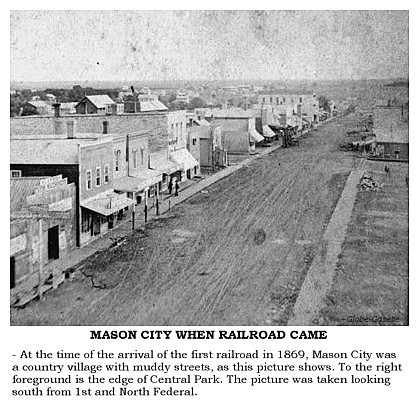
The first iron horse, a small, plodding wood burner, came puffing into Mason City on Nov. 7, 1869, pulling several cars over the newly completed tracks of the McGregor and Missouri River Railway Company (Milwaukee). Seneca F. Brown, father of Mrs. Jay [Angie] Decker, was at the throttle. Busy tossing wood into the engine was Rush Eddy. The coming of the train released a celebration such as had not been seen in the town before. Through the Cerro Gordo Republican, W. C. Stanbery issued orders that "any man found sober on the streets that day would be put in the caboose." Glasses were filled and emptied at the taverns and hotels and at the National House the celebration grew so boisterous that the floor gave way over the billiard room. NOTE: Seneca Floraine Brown was born in 1855/57, New York, and died in 1935,
interment made at Calvin Community Chapel Cemetery, Calvin Center, Michigan.
Mason City had a right to celebrate. The coming of the railroad was the realization of dreams and hopes that lived since the first cabins were built in 1853. It had been the big topic of conversation. With a railroad the town would grow and prosper. Without it the community might wither and die. The railroads, conscious of this unique power they wielded in the new country, could bargain effectively with the settlers. The coming of that first train marked a great triumph for the community, but in the arduous and costly efforts to procure it, there were left both tragedies and heartaches. As far back as 1856, the scattered residents of the county had voted unanimously to take $130,000 in stock in the proposed railroad, a terrific undertaking for those times, but indicative of how important a railroad was. Later came other concessions, including the deeding of 30,053 acres of land to the railroad by the county. At the time the first stock was subscribed in the county, everyone was sure construction would start at once. In the summer of 1857 a preliminary survey was made across Cerro Gordo County south of Mason City. Then began a period of waiting while the railroad made slow progress westward from McGregor. At that time the railroad was known as the McGregor, St. Peter & Missouri River Railroad Company, which had projected a road westward along the 43rd parallel through Charles City, Mason City and Clear Lake. It wasn't, however, until several reorganizations later and the offer of large federal land grants in 1854 that extensive construction got under way. Before this took place the McGregor St. Peter & Missouri passed into receivership to satisfy a judgment of $1,560. The old stock was wiped out and the Northern Iowa Railroad Company took it over. On Jan. 18, 1863, the McGregor Western Company was organized and purchased the franchise of the Northern Iowa Railroad Company.
The Northern Iowa had friends in high places and through the efforts of Rep. William B. Allison procured a federal land grant that meant railroad construction could proceed at a rapid rate. This grant included every alternate section of land designated by odd numbers for 10 miles on either side of the road. Indemnity lands within 20 miles of the roads could be selected if lands had previously been taken within the 10-mile limits. The grant was on condition that the railroad starting at McGregor would build "in a westerly direction, by the most practicable route, on or near the 43rd parallel until it shall intersect the road running from Sioux City to the Minnesota state line in the county of O'Brien." Construction of the railroad proceeded. By June, 1864, the track was completed to Postville and by April, 1865, it reached Osian in Winneshiek County. By the time the residents of Cerro Gordo, Floyd and other western counties became aroused. The railroad was being built along a route that swung northward St. Paul instead of west. Indignant citizens held meetings and protested. The McGregor Western Railroad was charged with non-compliance with terms of the Act of Congress, of evading construction of the railroad west along the 43rd parallel while attempting to grab the land grants. In the Feb. 8, 1866 issue of the Republican, Editor H. G. Parker reflected something of the ire of the community in an editorial. He had learned, he said, that the McGregor road planned to abandon the 43rd parallel "and continue their line from Calmar, the present terminus, in a northwestern direction to Austin in Mower County, Minn." He heard, he said, that "we are to be swindled out of our grant and the lands donated for the benefit of this hitherto neglected portion of Iowa, to be applied for construction of a road passing through Clayton and Winneshiek Counties into Minnesota. "We cannot believe the company will be allowed to perpetrate such a fraud upon the people for whose use the lands were donated." The land grants were canceled and not resumed until March 31, 1868, when they were given to a new company, the McGregor and Sioux City Railway Company, which emerged as successor to the McGregor Western. Meanwhile Mason City watched, waited and prepared. By midsummer of 1869 the railroad had reached New Hampton, by September it was in Charles City and not long afterwards was at the gates of Mason City. By that time the name of the railroad had been changed to the McGregor and Missouri River Railroad Company.
The strange thing about this transaction was that lands deeded to the railroad were not in Cerro Gordo County. They were 150 miles or more beyond its borders. Land descriptions in range 45 and 46 and in townships from 80 to 99 places them in the western tier of counties in Iowa from Lynn in the northwest corner southward to Harrison County, just north of Council Bluffs. How did Cerro Gordo County obtain these lands with which to bargain? The record isn't clear. It is known that in 1850 the U. S. government granted to the states the so-called swamp land within their borders. Iowa then granted these lands to the counties, supposedly ones in which the lands lay.
As far back as 1861, the county hired W. P. Hepburn, a swamp land agent, to go to Washington "and to use all necessary diligence to bring about the adjustment of the swamp land interests of the county" for which the county was to pay $200 down and $800 with the successful completion of the matter. Evidently Hepburn had been successful. Later he was elected to congress. William Peters Hepburn (1833 - 1916), an attorney and a Civil War veteran, served in the now-obsolete
8th Congressional District from 1881 to 1887 and from 1893 to 1909. He guided and sponsored many statutes which regulated
businesses, including the Hepburn Act of 1906 which authorized the U. S. Interstate Commerce Commission to require
railroads to charge "just and reasonable" rates. After he was defeated, he returned to the practice of law, first
in Washington, D.C., then in Clarinda, Iowa, where he died and was interred in 1916. With practically all land taken by settlers, making the alternating section grant void as far as this county was concerned, the indemnity lands was the one big inducement that could be given the railroad. At the time title to the land was in litigation with the American Emigrant Company claiming title by virtue of an old contract with the government. The railroad took the lands on this basis guaranteeing the county against all expense connected with the title. At the last moment, however, Mason City came near losing the road. The railroad company, despite its contract with the county supervisors, demanded that the city contribute $5,000 and half interest in the 160 acres in south Mason City, across which the railroad would run. Mason City refused and the company ran a survey line a mile and a half to the south. The railroad gave Mason City residents a certain number of days on which to agree to the demand. At 11 p. m. on the last day the indignant citizens of the community relented and the line was changed back and the station built on its present location. From Mason City the road pushed westward and reached Algona Dec. 5, 1870. For a time further westward construction was held up and the state withheld land grants because the McGregor and Missouri River Company failed to complete the line according to contract. Later the Chicago, Milwaukee and St. Paul Railway Company took over the railroad, completed the line to Sheldon and thus received the grant. It also built a branch from Mason City to connect with another line at Austin. The Chicago, Milwaukee and St. Paul Railway Company and its Iowa predecessors received 648,628.91 acres of land. So, while there was hilarity and rejoicing at the coming of the railroad, there were mixed emotions among those who watched that first train arrive. In the fringes of the crowd were hard-faced men who had lost their farms to pay for the stock they subscribed to bring the iron monster. Its coming had been costly, but it was well worth it. The railroad brought to the isolated town means of modern transportation to the outside world. It meant grain and other farm products could be shipped directly to Milwaukee and other points east. It meant more jobs, more homes, the growth of industry, a bright future. As that first train arrived steps had already been taken to organize a bank, to incorporate the town as a city, to start many other projects that come with faith in the future. The railroad marked the beginning of a new economy for both in town and country. A building boom got underway along Federal Avenue. At that moment two other rails were crawling northward from Eldora, adding further promise to the future. The costs and exasperations were soon forgot in the stir of events that lay ahead.
THE FIRST CITY GOVERNMENT
The group was Mason City's first city fathers, consisting of Mayor D. B. Mason, Trustees E. Lloyd, Elisha Randall, George Vermilya and A. B. Tuttle, Treasurer W. H. Lytle and Marhal F. J. Tunure. They had been named after the citizens of the village on Dec. 21, 1869, decided by a majority of 35 to incorporate. The official designation was made by Circuit Judge H. N. Brockway. At the March, 1870, meeting of the council, W. C. Stanbery assumed the office of mayor, but at the next session in April his office and that of the marshal were declared vacant for neither had provided the necessary bond. H. Keeler became mayor pro tem. Some weeks later A. B. Tuttle was named mayor and John L. McMillin, marshal, with five assistant marshals for emergencies. The council had an ambitious program that included the grading of streets, building and repairing sidewalks, levying taxes and better police protection. The first tax was a three mill levy. Other income came from fees. Magicians were charged $10 a performance, circuses $25, and concerts $10. Billiard or bowling alleys paid a license of $10 a year, hotels and taverns $2 a year, retail dealers in liquor $200 a year, and draymen $5 a year for each horse. To encourage law enforcement the marshal was granted the following fees: For arresting each person, $1.50, and for committing each person to jail, 50 cents. It was also the marshal's job to keep streets and sidewalks clean. When the new council took over March 7, 1871, with W. W. Knapp as mayor, a motion was adopted that "the new council furnish a good substantial supper for all present assembled." This was to become a custom for several years. The first step toward fire protection was taken Sept. 20, 1872, when $150 was appropriated for a hook and ladder. This was the beginning of a fire department that was to become famous in the years before modern equipment was provided. At the March, 1873, meeting an ordinance was adopted requiring each downtown building to have two casks of water for fire protection. As the costs of government will - they increased as the city grew. The first year it was $2,001.97. Three years later the budget was $2,720.42, but this included nearly $700 for sidewalk. They probably never dreamed in those days the city government would some day be a million dollar business. The growth of the city resulted in the platting of new additions, the construction of homes, and new business places. Most pretentious was the platting of 140 acres known a South Mason City to build up the area around the recently arrived Milwaukee Railroad. South Mason City was platted Oct. 19, 1869, by the following who gave half interest to the railroad company as a bonus for locating the station at its present site: Thomas G. Emlsey, B. F. Hartshorn, John Pratt, W. W. Allen, George Miller, L. J. Waterbury, John S. Stanbery, Russell Smith and their wives. This plat was surveyed by C. F. Vincent. Other additions followed. W. C. Stanbery filed one for the area along Federal Avenue to Willow Creek. Ben Randall extended the city northward and J. V. Mumford, set the stage for building up the area around the M. and St. L. station. James Foster platted a subdivision of South Mason City in April, 1882, followed by another in which H. G. Parker was associated. Parker also platted an addition to the west.

Men prominent in the professions, business and industry served on the city council. Among them were Elisha Randall, mill owner; H. G. Parker, editor; Dr. J. B. Dakin, W. B. Stilson, and John D. Glass, F. M. Goodykoontz, John Cliggitt, Duncan Rule and J. C. Sherwin, members of the bra. Sherwin was later to rise to the Iowa supreme bench. Others active in council proceedings were O. T. Denison, banker and brick and tile industry head, and Andrew Lien, quarry and lime kiln operator; A. H. Gale and James Rule, banker. J. J. Clark, later district judge, was for many years city clerk. In 1898 C. H. McNider was named treasurer, a position he held for many years.
The city census for 1880, showed a population of 2,510, a gain of 1,327 over the 1,183 of 10 years before. The city had now passed the 2,000 mark that made it eligible for designation as a city of the second class. Such steps were taken in 1881. New ordinances were adopted and John Cliggitt became the first mayor under the new setup in which the city was divided into three wards and councilmen replaced trustees. The first councilmen were: First ward, John Lee and Henry Keerl; Second ward, Andrew Lein and B. P. Kirk; and Third ward, L. A. Page and John F. Burns. The city continued to require more and more modern conveniences. At the March 28, 1881, meeting the council named a lamplighter, Russell Castler (sic). At the April 4 meeting that year W. E. Wood of Elgin, Ill., asked the city for a 15-year franchise in behalf of the Northwestern Gas Light Company to provide gas. The franchise was adopted. A month later an ordinance was adopted granting a right of way to the Iowa and Minnesota Telphone Company. NOTE: Russell B. Casler was born December 11, 1848, and died November 25, 1889, interment made at Elmwood-St. Joseph Cemetery. The first move for a city water system was taken June 6, 1885, with the purchase of machinery, pumps and pipe under the leadership of Mayor Denison. With the purchase of a two-wheel cart for $175 there came into existence the famous Denison hose company.
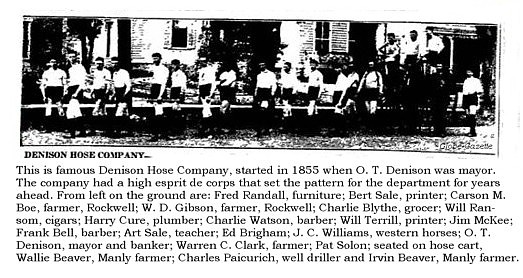
This volunteer fire department had a high esprit de corps and won prizes in speed and hose coupling contest and other events held at state tournaments each year. The community helped by having a Denison hose company ball each year on Thanksgiving night to provide funds for uniforms and equipment, one of the big social events of the year. In August, 1886, the city accepted the proposal of the Mason City Electric Company for street lights and on March 19, 1888, "authorized construction of gas and electric works." On Sept. 23, 1889, A. H. Cummings presented a petition signed by 300 for an "ornamental fountain in Central Park." This project engaged the attention of the council for months before its completion. At the Jan. 5, 1892, meeting a petition signed by numerous citizens asked that "smoke houses and houses for rendering tallow and lard be removed from the business portion of the city." By 1893, the hose company reached the conclusion it should have a chemical engine. The matter was under consideration for months until Jan. 3, 1895, when the city authorized the purchase of a 35-gallon engine at the cost of $1,640.
Extension of the water and sewer system occupied the attention of the council during the 90's just as grading and sidewalks had been the main problem earlier. On May 5, 1896, the council named C. T. Dike city engineer at $600 a year. Later [1903] he was to become chief engineer and vice president of the Chicago and North Western Railway. NOTE: Chester Thomas Dike originally taught at the John Main country school north of Mason City, prior to becoming involved with the proposed Mason City and Clear Lake Railroad as chief engineer. He was in charge of the construction of the electric railway. He was born on August 13, 1870, and died on August 2, 1958. Bonnie (Elder) Dike, his wife, was born May 9, 1875, and died August 13, 1966. They were interred at Elmwood-St. Joseph Cemetery. SOURCE: The Globe-Gazette, Saturday, March 23, 1940, Page 16.
Growth of the city caused the council on Jan. 29, 1897, to extend the city limits so that it included the north half of section 15 and the north half of section 16, Mason Township, pushing the limits southward, and the southwest quarter of section 4, the north half of section 4 and the east half of section 3, Mason Township, extending the limits northward. This action was ratified by a vote of 632 to 54. On Feb. 22, 1897, the council took action to pave Federal Avenue with bricks from Willow Creek north to Second, North. The paving was completed in 1898, paid for with at $3.27 a front foot tax levy. On Feb. 22, 1897, the council voted the Denison hose company an aerial hook and ladder truck at a cost of $2,700 and soon afterwards passed an ordinance regulating construction to reduce fire hazards.
WHAT MADE THE RAILROADS COME
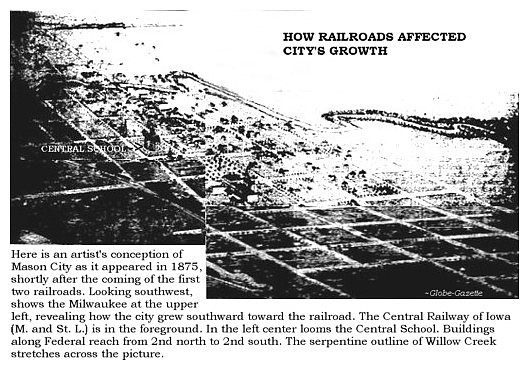
[Section 7, Page 13] It wasn't just an accident that Mason City became a railroad center. It took community enterprise and a willingness to give up some of the rewards of sweat and toil. Again and again the citizens of Mason City and of Cerro Gordo County voted by decisive margins to tax themselves to bring in another railroad. It is difficult for us in this generation of motor transport and surfaced highways to imagine how important railroads were. They were the lifeblood of communities and tied up irrevocably with their future. Still in vivid memory to these pioneers were the days and years when Mason City had no railroad. They were happy when the railroad reached Cedar Falls, a distance of 70 miles, and later was extended to Waverly on what became the Dubuque and Sioux City Railroad. Each week the newspaper ran the train schedule. The train left Waverly at 6:30 a. m. and arrived in Dubuque at 3 p. m. and left Dubuque at 10:30 a. m. and arrived at Waverly at 6 p. m. The long overland haul to Cedar Falls and Waverly for travel and for transporting produce and goods of all kinds over muddy, sometimes almost impassable, roads were not soon forgot when the first train arrived in Mason City. Out of the hardships of those years came the dynamic ambition to have railroads coming to Mason City from all directions. The main driving reasons why the community battled for more railroads was to enlarge Mason City's trade territory and to provide facilities whereby customers many miles from Mason City could make a shopping trip in one day. Mason City's concern with the development of a trade area was expressed by Editor H. G. Parker in the Nov. 14, 1863, issue of the Cerro Gordo Republican. Commenting on the brisk business merchants were doing he added this explanation: "The large assortment which they now keep, the small profits which their increasing sales enable them to take, together with the prices they pay for all kinds of farm produce, compared with eastern quotations, has induced the farmers to market their products at home." This was written before the coming of the railroads. It revealed that the merchants offered to buy farm produce from the farmer and haul it 70 miles to the nearest rail connection and pay the farmer a better price. The merchant, it was reasoned, could haul the grain at a lower cost because he would come back with a full load of supplies for his store. Then the editor added this remarkable prophecy: "With the present arrangement we expect the business of our place to increase from year to year with great rapidity." Taxes were voted not only for railroads that came, but also for others that never materialized. This willingness to sacrifice for the present in order to invest in the future accounted in part for the fact that Mason City pulled ahead of its neighbors. In one instance only did Mason City fail in providing sufficient appeal to draw an approaching railroad. That was when it allowed a railroad headed in this direction from the southeast to miss Mason City by 10 miles. We have told the story of the impact of the first railroad in Mason City. The arrival of the second, the Central Railway of Iowa, later to become part of the M. & St. L. system, was also of immense importance, providing as it did north and south outlets. It made coal readily available. It made Mason Cityans feel they were going places.
Central of Iowa came with no land grant, although it tried its best to get some of the lucrative allotments given the Milwaukee. It did, however, receive a generous donation from the taxpayers in the form of a 5 per cent levy. Townships through which the railroad was built joined in voting tax assistance. Agitation for a north and south railroad had been going on for years. As far back as Dec. 20, 1865, the county supervisors voted $150 aid for a survey. In June, 1868, the board appropriated $300 more. By this time, says an early report, Mason City was represented on the board of the railroad. The railroad got its start when coal was discovered near Eldora. To ship this coal the Eldora Railroad and Coal Company was formed Feb. 7, 1866, to build a railroad to Ackley, 16 miles north. This provided a connection with the Illinois Central so coal could be shipped to Sioux City and Dubuque and points between. On Sept. 1, 1869, the Eldora line was sold to the Iowa River Railway Company, which started building south to connect with the Chicago & Northwestern at Marshalltown. In 1870 the road was pushed north to Mason City and by 1872 it was completed from Northwood to Albia, a distance of 190 miles. Not long after this it was possible, by connecting with other railroads, to travel from Mason City to Minneapolis or St. Louis. Meanwhile there was being built in southern Minnesota the M. and St. L. Railroad, with which the Central of Iowa, later called the Iowa Central, eventually was to merge. The M. and St. L. had pushed its line southward to the Iowa border and by connecting with other railroads had developed a large business. Edwin Hawley, who became president of the M. and St. L. in 1895, was quick to sense the importance of the M. and St. L. as a compliment to the "Louie." Both roads as separate units were weak. United they would form an outstanding system. By 1900, Hawley acquired control of the Iowa Central. Joint operation of the two systems led to their eventual merger in 1912. Only two years after the Central of Iowa - 1872- another railroad was pushing its way toward Mason City from Cedar Rapids. The Burlington, Cedar Rapids and Northern (Rock Island) was headed this way with the apparent intent of coming to Mason City. The construction had proceeded to Rockford when Mason Township voted a 3 1/2 per cent tax to the railroad. Then to Mason City's dismay the railroad instead of following the Winnebago River valley to Mason City went up the Shell Rock to Nora Springs and from there to Manly, across the northeast corner of Cerro Gordo County. Mason City had been bypassed. Nevertheless the railroad provided an outlet to the southeast until such time that another railroad could be built. Meanwhile plans were in the making for a railroad outlet to the southwest. As early as September, 1871, the county supervisors voted $300 for the project. At an election on March 31, 1873, the county voted 411 to 11 to give the St. Paul and Southwestern Railway swamp land indemnity funds, that included a $7,250 draft in a Des Moines bank. But this company did not build the railroad. That wasn't to come until 1886 when Hamilton Brown of Boone constructed the Mason City and Fort Dodge Railroad [incorporated June 10, 1881, organized June 14, 1881], a 90 mile stretch of rails that was eventually to become part of the 1,500 mile system of the Chicago Great Western Railway, which stretches like a giant cross from Minneapolis to Kansas City and from Chicago to Omaha. The discovery of coal near Lehigh, a few miles southeast of Fort Dodge, proved an early [1886] boon to the railroad. Excursions were popular and one passenger train and one freight train operated in each direction every day. At the same time the Minnesota and Northwestern Railroad constructed its first unit of track from Lyle, Minn., to St. Paul and on Nov. 28, 1885, a branch line was completed from Lyle to Manly, Iowa. On April 30, 1901, an agreement was entered into with the Mason City and Fort Dodge Railroad Company to take possession of the lines of that company, including the line between Mason City and Manly built that year, completing a physical connection between the two railroad. In 1903 the line was extended from Fort Dodge to Omaha. Acquisition of more branches followed and later all became part of the Great Western system. To encourage the construction of the Mason City-Manly gap the Mason City Terminal Railway Company was organized and on July 11, 1892, the city voted a 2 per cent tax. On the day following a similar vote placed a 3 per cent tax at the disposal of the Terminal Railway for a railroad to Forest City. NOTE: The Mason City terminal
for the Mason City Terminal Railway Company was the Minneapolis & St. Louis Railroad depot, located on 4th Street N.E.;
Clear Lake's depot was located at the "Oaks Hotel" on the lake front. In the early 1900's the company was re-named
Mason City & Clear Lake Railway. Peoples' Gas and Electric Company acquired the operation in 1910 and changed the name
to Mason City & Clear Lake Railroad Company. In 1913, the railroad and utilities were acquired by the United Light and
Railways Company. The final run of the interurban passenger service was on August 30, 1936; services were continued
by bus until 1955. The Iowa Terminal Railroad, a successor to the Mason City & Clear Lake Railroad was established in 1960.
A group of five men, headed by David Johnson, purchased the Iowa Terminal Mason City Division in April of 1987, and the
company was named The Iowa Traction Company. The Mason City & Clear Lake Electric Railroad Historical Society, Inc. was
established in August of 1987. Among various projects, this society plans to rebuild the track between Clear Lake and Emery which had been
removed at various times between 1947 to 1967.
The city records also show that on May 31, 1893, the citizens of Mason City voted at a special election by 149 to 92 to levy a 5 per cent tax to aid the Winona, Osage and Southwestern Railroad in building a road from Mason City to Osage. These taxes, although ordered spread on the records, were never collected for the railroads were not built, except for the Mason City-Manly line constructed by the Great Western. In Mason City's restless dream of growth some plans went awry. But there were other, great dreams, destined for fulfillment. At the April 11, 1899, meeting of the city council there was presented a petition to hold an election to submit to the voters the question of aiding the Minnesota and Northwestern Railway in the construction of its railroad from Mason City southeast. On April 22 of that year Mason City voted 213 to 112 to levy a 2 1/2 per cent tax for that purpose. The contract provided that the railroad build a "good substantial passenger and freight depot." The building of that railroad is another chapter in Mason City's mighty railroad development.
MONEY PANIC NIPS RAILROAD BOOM
When the Milwaukee Railroad came to Mason City in 1869, followed a year later by the Central Railway of Iowa (M. & St. L.) from the south, the country was nearing the top of a post-war posterity wave. With the country in this mood, Mason City felt doubly prosperous. A tremendous building boom developed. Business buildings on both sides of Federal were extended northward to present 2nd Street, north. The financial panic in Vienna was the first danger signal. European financiers became cautious and ceased buying American bonds. The great New York banking house, Jay Cooke and Company, went bankrupt, creating consternation throughout the nation. This was the start of a depression that lasted several years. Prices of farm products and to half and less of their former levels. Farmers, generally, were in distress. Their reduced buying power soon cut into Mason City's railroad boom and for years a number of Federal Avenue buildings stood empty. Despite this, new business institutions were started and the town continued to grow, drawing upon a continually widening trade area. Farmers came from long distances, bringing their grain and making their purchases because Mason City merchants provided extraordinary service.
In the May 2, 1867, issue of the Cerro Gordo Republican, Atty W. C. Stanbery inserted a notice that all farmers will be supplied with flour payable in wheat the next fall. Farmers were urged to sow a large acreage and to let needy neighbors have seed. "Never," added the editor, "since we have been a resident of Iowa has there been such a scarcity of grain and all kinds of provisions." The result was that a larger acreage of wheat was sown and the shortage alleviated. The Milwaukee Railroad wasn't more than built into Mason City when Valentine and Keeler started a grain buying business at the station. The next year they built an elevator. W. W. Cameron built a 6,000 bushel elevator on the Central of Iowa and in a year shipped 120,000 bushels of wheat to Chicago, Milwaukee and St. Louis.
In 1875 Lytle sold his bank to H. I. Smith, medal of honor soldier in the Civil war, who assumed the presidency, and J. V. W. Montague, father of Jamie Montague, famous columnist, cashier.
Charles was the son of Tom McNider, who came to Mason City as a grading contractor with the Central Railroad of Iowa (M. and St. L.). The boy's entry into the bank was the humble beginning of an illustrious career. McNider was later joined by two others who were to follow him up the ladder in the bank. Willis G. C. Bagley at 16 years of age started in 1890. He was to succeed McNider as head of the bank. Carl A. Parker in 1892 joined the organization and was serving as vice president when he retired.
Meanwhile other banking institutions were started. In 1873 Thomas G. Emsley opened the City Bank, later to be known as the City National Bank. Mrs. Emlsey, who had previously demonstrated business ability, was the cashier. When Emsley died in 1888, Mrs. Emsley took over the bank as president and continued as such until its reorganization as the City National Bank. As the bank expanded O. T. Denison and later James Rule became identified with its management. The bank stood on State and Federal on the present [1953] site of Goodman's Jewelers.
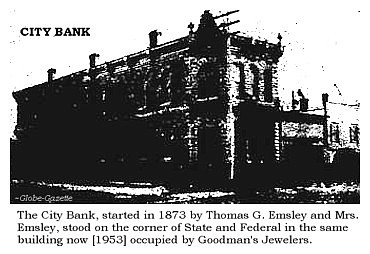
NOTE: Thomas Goodwillie Emsley, son of W. W. and Beatrice H. (Donaldson) Emsley, was born in Carroll County, Ohio on December 23, 1843, and died June 7, 1885 in Nebraska. He was a Civil War veteran. Mary Ann (Church) Emsley, his wife, was born October 8, 1839, Springboro, Pennsylvania, the daughter of James Emery and Julie Cody (Bailey) Church, and died in Mason City on March 21, 1931. She was a suffragette and worked to establish a free public library in Mason City. They were interred at Elmswood-St. Joseph Cemetery. In 1880 a third bank, the Commercial Exchange, was organized with H. P. Kirk as president and I. R. Kirk as cashier. At first a private bank it was later organized as a savings bank with capital increased to $60,660 and the name changed to the Commercial Bank. In 1880 the Mason City Building and Loan Association was organized to provide added service to the community.
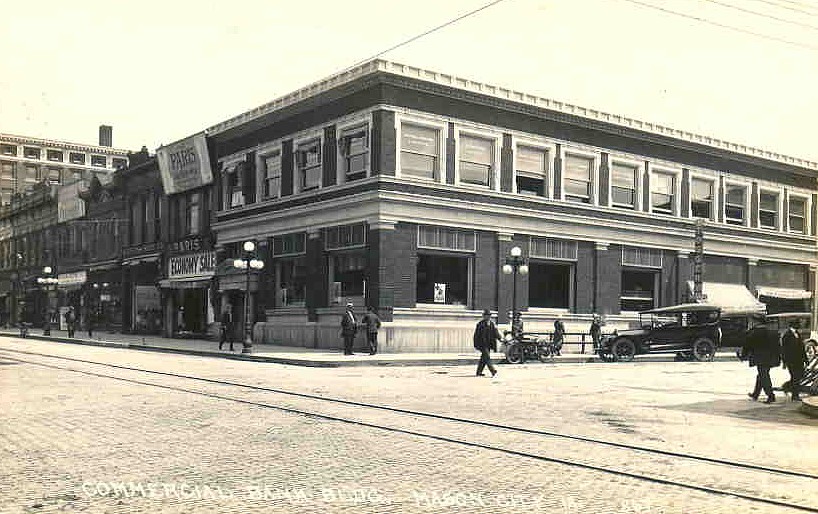
No institution is a better barometer of a community's business life than the postoffice. The year the first railroad came Dr. Silas Card became postmaster at a salary of $25 a month. Eight years later the salary had been upped to $1,800 a year. Volume doubled and redoubled. Mason City was made a money order postoffice in 1870. The first money order was issued to Edwin Woodman, Monroe, Wis., on Aug. 11, 1870 to the amount of $25. It was an energetic, restless, but resourceful group of business men that operated on Federal Avenue in those days. Stores were started, bought and sold in rapid succession. Among the new establishments that came with the rising tide of the 70's was M. Tiffany and Brother, who opened a grocery store. Tiffany later sold out to his brother and with William Ensign bought a stock of ready made clothing. He then disposed of his interest and with William Wright started a dry goods store. In 1881 he entered the grocery business.
NOTE: Major Tiffany was born April 20, 1829, and died December 2, 1912. His wife, Carrie E. Tiffany,
was born October 25, 1844, and died December 28, 1913. They were interred at Elmwood-St. Joseph Cemetery. Griffin Brothers started a grocery in 1874, which later was sold to S. S. Bagley, father of Willis G. C. Bagley. Another retailer in this period was Daniel McGrigor, who came to Mason City in 1865 with 10 cents in his pocket. Saving the money he earned as a day laborer, he entered the furniture business and later with D. J. Purdy operated a grocery. Later they switched to clothing and moved to Spencer. Wiped out in the grasshopper plague, they returned to Mason City with the stock which they closed out.
NOTE: Daniel McGrigor was born October 30, 1841, and died June 5, 1911. Marilla McGrigor was
born May 26, 1841, and died July 18, 1926. Phebe Dean McGrigor was born April 1, 1806, and died March 17, 1876. Interments
were made at Elmwood-St. Joseph Cemetery. The first exclusive clothing store was started by R. Babcock, followed by Dan Hay and the firm of Schleshinger, Frankel and Company. The Pratt Brothers started a dry goods business in 1870, continued to 1877 and then moved to Greene. Another merchant of this period was A. B. Tuttle, who was engaged in several ventures. NOTE: Rodolphus
Babcock was born in Scott, New York, November 8, 1831, and died in Mason City August 8, 1905. Mary Elizabeth (Schermerhorn)
Babcock, his wife, was born June6,1837, Worcester, New York, and died March 1, 1907, Mason City. Interments were made at
Elmwood-St. Joseph Cemetery.
Hardware stores made their first appearance in 1870, started by Lloyd and Wall and by W. W. Toddy. In 1882 W. J. Knovlinka opened a large hardware business. John Bush and Son had an agricultural machinery shop. The Allen House was built north of Central Park on Federal in 1871 and ranked as the best hotel until 1896 when the Hotel Anderson (now the Cerro Grodo) was built, followed two years later by the Wilson (Eadmar). The St. Charles, erected in 1871, stood on 2nd and North Federal. Henry H. Shepard, father of Hugh H. Shepard, founded the Shepard Abstract Company in 1877. L. A. Page came to Cerro Gordo County in 1870 and in 1880 started the L. A. Page Lumber Company. This is among the oldest mercantile concerns in Mason City. C. P. Shipley came to Mason City in 1873 and shortly afterwards started the job printing business. E. R. Bogardus came to Mason City in 1859, and in 1873 he entered the building and contracting business.
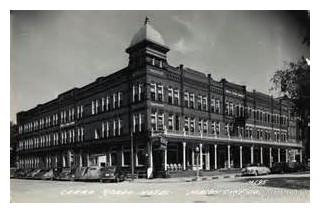
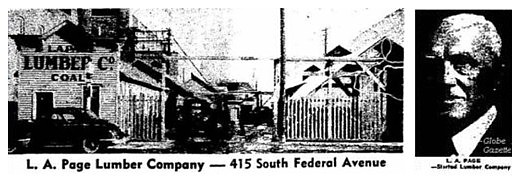
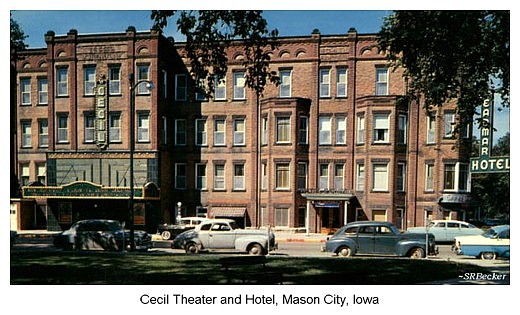
The first telephone was used in Mason City July 18, 1878. It was built by John W. Wilson and George H. Purdy and extended from 313 Delaware S. E., to where the Lapiner Motor Company now [1953, 29 1st Street N.E.] stands. The first long distance line extended from Algona to Mason City in 1878. The Iowa Union Company built the first exchange in Mason City about 1885. It was sold to the Greene and Western Telephone Company about 1895. This property was purchased by the Western Electric Telephone Company in 1891 and the name changed to the Western Electric System in 1905. The property was transferred to the Northwestern Bell Telephone Company June 1, 1929. C. Curie started a hardware business in Mason City in 1891. He was succeeded by his son, Frank R. Currie, who was joined by J. A. Van Ness. R[ichard]. L. Currie, grandson of the founder, is now [1953] active head of the business. NOTE: Corey Currie was born
July 16, 1847, Whitby, Ontario, Canada, and died in 1942. Louisa Harriet (Bond) Currie, his wife, was born September 29, 1849,
Green Lake County, Wisconsin, and died in 1934, Mason City. Interments made at Elmwood-St. Joseph Cemetery. Just before the turn of the century a number of larger establishments were added to the commercial life of the community, among them Letts, Spencer, Smith Company (Western Grocer) and E[dward]. B. Higley Company [1880], large produce house. Bate and Vroon, grocers; two drug stores, J. W. Adams and J. H. Atkinson, Cobb's House Furnishing and Hitchcock's Printery, were also established. In 1894 T. R. Glanville founded the Glanville Dry Goods store, which later became Killian's, then Merkels and, finally, Aldens.
NOTE: Edward B. Higley was born October 24, 1832, Windham, Ohio, and died March 13, 1920, Mason City.
He served on the city council from 1898 to 1904 and was a member of the Mason City Park Commission. Upon his death, he bequeathed
his home to Mason City to be converted into a home for elderly women under the name of "The Julia M. Higley Home" in
honor of his wife who preceded him in death. He was interred at his town, Windham Cemetery, Ohio.
SHOESTRING DISTRICT PAYS FOR SCHOOL
To provide this, the school board in 1872 took a bold step and erected a three story stone building that for years was to tower over the countryside, a building large enough to house both grades and high school. It was a daring project for so small a community. It was truly the venture of men who believed in the future of their city. But even bolder, or at least most ingenious, was the method adopted to pay the $30,000 cost of the building by enlarging the Mason City independent school district by 60 square miles, thus giving many more property owners of the county an opportunity to help pay for and maintain the school. The board proved as adept at gerrymandering as experienced politicians. The district became a zigzag corridor leading to a large area in the southwest corner of the county, where the land was owned by eastern investors.
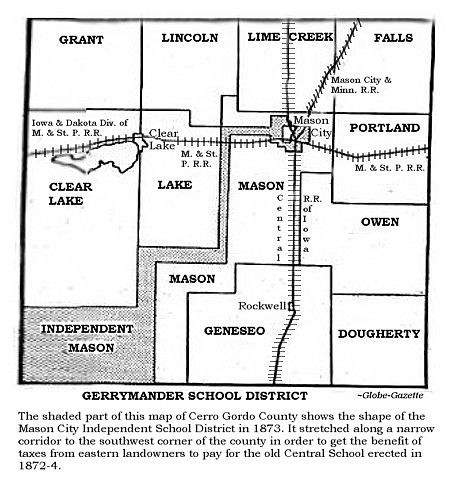
As shown in the map above, the "shoestring" district was a half mile strip going three and a half miles west from Mason City, then south eight and a half miles. It then became a mile wide strip going west five and a half miles and south three miles to a large area of what is now Grimes Township. This strange creature of the Gerrymander's art wasn't created without some pangs of conscience on the part of the community. In the Feb. 13, 1879, issue of the Cerro Gordo Republican, Editor Silan Noyes has this to say: "It is a fact that every citizen in the town has been ashamed to look at the map of the Independent School District of Mason City for the past two or three years. The notoriety of the crooked zig-zag lines of the district is not only local but had become statewide. "It is high time that a change should be made. We know the special plea will be made that owing to the heavy debt that now hangs over the district, we will need every cent of revenue we can get. "The plea is granted as far as our wants are concerned but we cannot afford to advertise ourselves as sharpers and knaves in order to secure a few dollars. Therefore we hope if the territory embraced in the serpentine lines of our district desires to be set off that it will be done at once." Soon after this a new township was created and the Mason City district became the area in and immediately surrounding the city. But by that time much of the building cost had been raised, a larger population supported the school and the first class had been graduated from the high school. This old central school, built of stone from local quarries, was to stand for more than a half century as a landmark. it was erected in the center of block 26, which in the original plat of Mason City had been set aside by Long and Brentner for a county courthouse. With Block 26 and other properties tied up in receivership and litigation, the county built the courthouse on the rim of Central Park. As an aftermath of the 1857 panic judgments were entered by eastern creditors against most of Mason City's real estate, which was sold at sheriff's sale. Title to much of the property had to [be] quieted by a deluge of quit claim deeds. Such was the situation with Block 26. The school district acquired title on March 12, 1872, by a quit claim deed given by Thomas G. and Nancy M. Hartshorn for $850. Later in the year the county supervisors voted a quit claim deed, thus abrogating any claim the county might have. Contracts were let for the erection of the building, which many settlers felt was so large the rooms would never be fully occupied. But the board was confident. Two years before - June, 1870 - a proposition to build a county high school in Lake Township, midway between Mason City and Clear Lake was defeated 463 to 269. This made certain Mason City's dominance in education for the surrounding area. A bond issue of $20,000 was voted and taxes were assessed for the additional $10,000. The cornerstone was laid July 4, 1872. E. C. Moulton, county superintendent, delivered the address. A tin box containing a copy of the school laws, the Mason City Express, court calendar, Moulton's address and three half dollars were placed in the stone. These items were found in a badly decomposed condition after a fire destroyed the building Dec. 14, 1926. Three stories in height, besides the basement, with a cupola surmounted by a flag staff, the building became an imposing sight. Hung in the cupola was the old bell taken from the first two room school. Members of the board at this time were Horace G. Parker, father of C. A. Parker, A. B. Tuttle, Dr. W. W. Allen, George W. Sanborn and D. M. Tiffany.
A serious delay took place in the construction of the school. The contract for the erection of the building was let by public bids and bonds put up and the building contract signed by the builder with County residents for a brick building. The contract was changed and a stone building erected without consent of the bondsmen. This oversight cost the district dearly. The basement and all of the first story walls were put up and the partition walls for the second story, the contractor being paid on estimates as the work progressed. At this point the contractor quit work and left. The building was left standing in this condition for a year or more and then the school board proceeded to procure materials and labor and finally completed the building in the fall of 1874. The board then commenced suit against the contractor and bondsmen for the excess cost of finishing the building over the contract price. The suit was tried in Marion County. The board was given judgment against the contractor from who[m] they were unable to recover the loss, but not against the bondsmen as they had not consented to the change from brick to stone. Besides the cost of the stone construction was shown to be higher than brick.
While the building was under construction school was held in the old stone school and in store buildings downtown. Dedication of the building took place Oct. 9, 1874, with J. C. Gilchrist, Mason City's first superintendent of schools, giving the address. A cornet band and a choir provided music. A. B. Tuttle of the school board presented the building to the people of Mason City. Gilchrist went on from Mason City in 1875 to become the founder and first president of Iowa State Teachers College at Cedar Falls. He was to be the first of a number of Mason City school men and women to rise to prominence in the state and nation. NOTE: Prof.
James Cleland
Gilchrist was born in 1831, Allegheny City, Pennsylvania, grew up on an Ohio farm, and died at his home near Laurens, Iowa on
August 12, 1897 at the ages of 66 years. He came to Iowa in 1871 and was involved with school work in Mason City, Sioux City and Algona. Upon
establishing the Iowa State Normal School at Cedar Falls, he became the institution's principal and held that position
for ten years. An ordained Methodist minister, his main interest and work was conducted in the field of education.
A contemporary of Mrs. Chapman was Herbert Quick, who for four years was principal of the four-room Garfield School while reading law in the office of John Cliggitt. "In actual good," Quick wrote later in his "One Man's Life," "I don't believe I ever accomplished more than in those four years as principal of the south side school." By 1878 the high school, which occupied the third floor of the building, graduated its first class. The seven graduates were: R. W. Montague, Ellen A. Barton, R. J. Miller, Minnie Egloff (Long), Ella Mayne (Lucas), Alpha Valentine and Lucy Barton (Alexander). School enrollment grew so rapidly that by 1890 a red brick building was erected to the east of old Central at a cost of $15,000. It was originally used as a high school and later as a grade school.
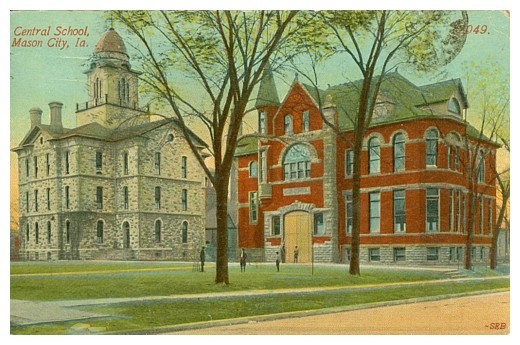
The growth of the city southward toward the Milwaukee tracks made necessary two grade schools in that area. A four room Garfield School was built in 1882 at 318 Sixth S. E. In 1900 four more rooms were added and later the entire structure was rebuilt.
The first unit of the Grant School, 503 Sixth S. W., was built in 1884. It was enlarged in 1900 and again in 1912. Later the entire structure was renovated.
But the city was also growing northward. In 1890 the first unit of the Washington School, 7th and Washington
INFANT INDUSTRY BECOMES A GIANT

[Section 7, Page 16] A number of infant industries flourished and faltered in Mason City from 1870 to the end of the century. Some lived but a brief periods while others went on to become industrial giants. The city's first industry, Elisha Randall's saw and grist mill on the Winnebago River, was rebuilt for flour milling at a cost of $5,000 in 1875. A new and larger dam was constructed. The next year the mill, which had a capacity of 80 barrels a day, was sold to J. T. Elder. Also operating at a capacity of 80 barrels a day was H. G. Parker's flour mill built on Willow Creek in Rock Glen in 1870. The dam of this mill still stands. Another industry that developed from products on the farm was Palmeter Cerro Gordo Cheese, which found a market in the east even before the coming of the railroad with an annual production of 15,000 pounds.
The Liens shipped several thousand barrels of lime each year, mostly to the quarry-less region west of Mason City. Tram cars were used to convey the rock from the quarry to the kiln. Coal was used as fuel, with three tons of the fuel making 150 barrels of lime. Another lime kiln was operated by L. L. Huntley and W. O. Barnard. NOTE: L. L. Huntley was born March 24, 1824, and died June 19, 1907, interment made at Elmwood-St. Joseph Cemetery.
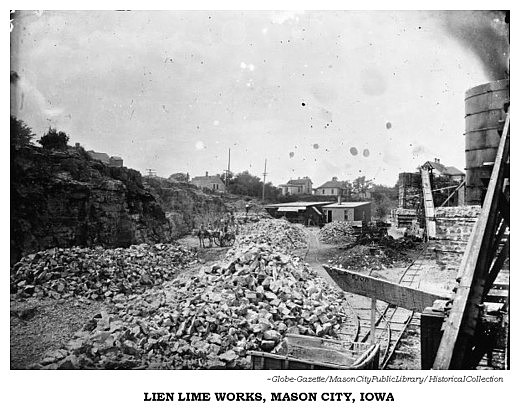
In the early years many residents believed the peat beds in North Iowa sloughs would be a tremendous source of fuel and geologists so suggested after extensive surveys. With the coming of the railroad from coal mines to the south, talk of burning peat disappeared.
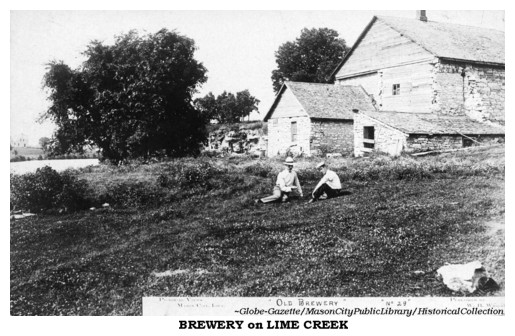
NOTE: Mitchel R. Brahm, an immigrant from Germany, arrived in Mason City around the year 1875. The Brahm family resided in Lime Creek Township near the brewery. The farmers began experiencing some difficult years when their barley crops were plagued with grasshoppers and locusts, around the time Mason City passed an ordinance in 1879 which prohibited the sale of beer. According to the 1880 census, Brahm sought employment as a carpenter. He died in 1912. In 1876, John Schaefer arrived from Willmar, Minnesota, to join Brahm as a business partner. The property was sold at a sheriff's auction to Byron Garnidge who in turn sold the property the following year to Christian Neuhaus and Mitchell Brahm. In July of 1882 a law prohibiting the sale of any liquor passed which shut down all brewing activities in Mason City. SOURCE: masoncitybrewing.com/history.html

NOTE: On November 15, 1871, Dan and Joseph Farrell sold the brewery located on Carolina Street, just
north of 4th Street N.E. on the south side of the river, to Samuel Wyatt and Joseph Dorfner. The land also contained 20 acres
of timber. Dorfner and his wife ran the brewery and Samuel Wyatt sold his share of the timber to John Baum. Dorfner and Baum
sold the brewery to Milton A. Price on January 3, 1873. The brewery was destroyed by fire in April of 1873. At some point,
Dorfner bought back the land and erected a large limestone brewery that was two and one-half stories tall. After operating
for three years, the property was sold at sheriff's auction in August of 1874 to E. R. Lloyd to satisfy Dorfner's debt of
$366.07 and $38.40. Mitchell "Mike" Brahm and H. W. Burdette purchased the brewery in November of 1877 and remodeled it.
By 1888, Dorfner and his family moved to Tacoma, Washington, where he was employed as a brewer. In 1890 the building was
sold to the Mason City Creamery Company and remodeled into a creamery, and was run by O. T. Dennison, president, and
A. J. Miller, secretary. It was purchased in 1892 by Samuel and Joe Kennedy, continuing the operation as Kennedy Creamery.
In 1895 H. J. Turner assumed ownership and continued the creamery operation. Bickel Produce Company later acquired the
property, then later is was acquired by a private individual. SOURCE: masoncitybrewing.com/history.html

No one at that time could have dreamed this was the beginning of an industry that would make Mason City one of the brick and tile capitals in the country. In 1875 Brickson withdrew from the partnership and Nelson carried on alone, continuing to expand to the point where the yard turned out 400,000 bricks in 1882. Brick came to be used in Mason City buildings and was shipped as far west as Sanborn. NOTE: The first brick fired in Mason City was by Nelson Gaylord in 1861, using
temporary kilns on the site.
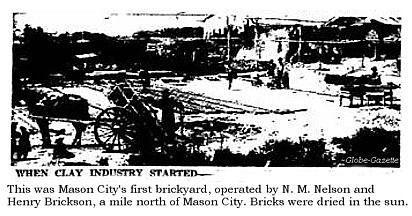
Then two things happened. Nelson's expanding industry caught the eye of leading business men in the community and geological surveys revealed that deeper deposits of clay lay immediately south of Mason City. These deposits were 40 feet thick of blue and yellow clay that could be blended effectively in brick making. Nelson became associated with Ed Barr and started a brickyard [1884] in this more productive area on the site [located 1/2 mile west of the train depot] of the original No. 1 plant of the Mason City Brick and Tile Company. When a company was formed in 1892 and capital subscribed for larger operations, Nelson sold his share of the south brickyard. Barr became the temporary head of the new company which was organized in 1884, with the following officers: Barr, president; D. J. Farrell, vice president; R. Valentine, secretary-treasurer; James Rule, F. M. Norris and O. T. Denison, directors. In 1892 it was incorporated as the Mason City Brick and Tile Company. [The brick works was serviced by a rail spur from the Chicago, Milwaukee & St. Paul Railroad.]
In January,1895, F. E. "Fred" Keeler, Denison's son-in-law, who had started his career in the First National Bank, was taken into the company as secretary-treasurer. [L. W. Denison served as secretary-treasurer for a time.] In 1902, Keeler was made vice president and upon the death of Denison in 1920 succeeded to the presidency of the company.
NOTE: The Patron's directory of 1912 listed the Mason City Brick and Tile Company as "Manufacturers of Wire Cut
Brick and Drain Tile, Vitrified Paving and Sidewalk Brick, Dealers in St. Louis Firebrick and Fire Clay.
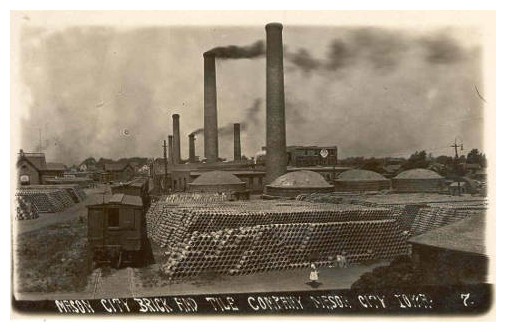
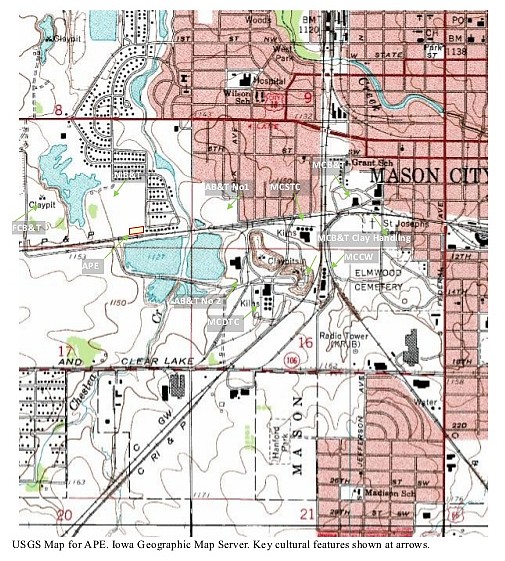
As the century neared its close Denison and his associates turned their attention to another industry, that of a beet sugar factory. The Cerro Gordo Sugar Beet Company was organized and meetings of a Sugar Beet Grower's Association held, but not until two decades later was a factory to be built in Mason City. Meanwhile other industries were gaining a foothold. The first feeble beginnings of the mighty electric light and power industry came into being when M. I. Clark supplied the first commercial power for arc lamps in Mason City in 1885, but the firm closed in 1887. The plant was reopened in 1889 by Mrs. Clark with a 150-horse power engine. In 1892 the Clark company built the first unit of the present [1953] power plant and changed the name to the Mason City Electric Company. The big expansion of the plant was to come in succeeding decades.

Probably the most colorful of all industries in Mason City during this period was that of the newspapers, with three members of the Stanbery family playing the stellar roles headed by the resourceful and irrepressible Recompense (Rec) Stanbery. Until December, 1870, the community had only one newspaper. But the coming of railroads provided the incentive for J. H. Hamlin and J. R. Kirk to start publication of The Mason City Express. Less than a year afterwards, in July, 1871, they sold out to Will Ed Tucker and H. R. Spink. Tucker and Spink published the Express until June, 1874, when Spink became sole proprietor, Tucker remaining as editor. In April, 1876, Tucker bought the paper, remaining editor until in the 80's when the paper was consolidated with the Cerro Gordo Republican. The Republican, founded in 1862 and edited through the Civil War period by H. G. Parker, was bought in 1873 by Silan Noyes, who previously had owned half interest in the publication, and George R. Lanning. After the death of Noyes in 1875, Lanning continued with the paper until 1876, when John West took the plant in payment of a debt. On Nov. 1, 1878, West sold the paper to W. V. Lucas, Civil War captain, who came to Mason City from Waverly. A year later Lucas sold half interest to C. G. Sargent, who retired the following March 1, leaving the paper to Lucas and his son, A. B. Lucas. In April, 1883, Lucas and Son sold out to Leo Chapman, who came from Des Moines. In his management of the Republican, Leo Chapman was assisted by his talented wife, Carrie Lane Chapman [Catt], who afterwards achieved world wide fame as a woman suffrage leader. During the later 80's the Republican passed into the hands of L. L. Klinefelter after which its merger with the Express took place. The paper now became the Express-Republican under the joint ownership of Tucker and Klinefelter, who soon afterwards sold to Bailey Brothers. In the early 90's Charles K. and F. W. Myers bought the paper, retaining possession until1906 when they sold out to the Stanberys, who sold out to the Times-Herald in 1909. Under Myers' ownership the paper dropped the hyphenated name and was called the Republican. Ed Tucker revived for a short time the weekly Express, which he suspended about in 1899. The Stanberys, Rec, Harry and "Mose," were dominant factors in the newspaper life of the community. They had a part in the ownership of every paper during those years. They started two of them and on several occasions were on hand to pick up a paper when bankruptcy of other financial difficulties placed it on the bargain counter.
In 1888 Stanbery sold the Times to W. W. Goddard, who had come to Mason City the year before from Sioux Falls and started the weekly Herald. The Herald was merged with the daily to form the Times-Herald, which Goddard continued to publish until 1897. The Stanberys, however, did not remain for long out of newspaper ventures. In 1887 Will Ed Tucker and Harry E. Stanbery founded the Mason City Gazette, a weekly.
In the fall of 1893, Rec Stanbery as publisher, N. V. Brower as editor and Charles H. Gelo as city editor, founded the Daily Globe, named after the St. Paul Globe, on which Gelo had worked. It was started as a morning paper, but soon changed to evening.In 1894 Stanbery sold half interest to W. H. Peedan and the next year sold the other half to Capt. S. A. Marine, a Civil War veteran. Peedan and Marine soon afterwards purchased the Gazette. By 1897 the Times was hopelessly bankrupt and again came off the bargain counter into the hands of the Stanbery trio. They soon disposed of the property and for the next several years there were many twistings and turnings in the paper's ownership. Emory H. English of Des Moines finally became editor and part owner. In 1910 he erected the Times building at 19 West State to house the publication. W. F. Muse in an account of the newspapers of this era tells of the brief existence of the weekly Star, founded by Burleigh Milton, later sold to E. W. Trezise and finally absorbed by the Globe-Gazette. In 1898 came the historic transaction whereby Peedan and Marine sold out the Globe-Gazette to W. F. Muse and Dave Conroy, with which the other newspapers in Mason City were finally merged, the Republican in 1909, and the Times in 1918.
NOTE: Recompense "Rec" Stanbery, son of William C. and Eliza J. (Stettler) Stanbery, was born Dec. 13,
1855, Vinton, Iowa. He establish The Clear Lake Moon, then went to South Dakota to establish
The Mitchell Republican which he operated until October of 1882. Returning to Mason City, he resurrected The
North Iowa Journal as The Mason City Times. He married Emma Lawrence of Charles City in October of 1878.
SOURCE: History of Franklin and Cerro Gordo Counties, Iowa. 1883.
POLITICAL BOSSES RULE COMMUNITY
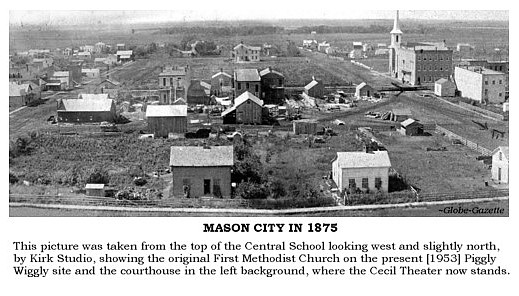
[Section 7, Page 17] Political bosses were an acknoledged part of the Mason City scene in the final decades of the 19th century. No one handled the role with finer finesse and bold maneuvering than did James Rule, president of the City National Bank and father of the late A. L. Rule. At that party nominations were by caucuses and conventions, which were noisy and of almost interminable length. In those political gatherings Jim Rule moved with a sure and masterful hand, but at times also met defeat. Among those who came to grips with Jim Rule to learn the hard, remorseless rules of politics was Herbert Quick, noted author who in the 1880's studied law and taught school in Mason City. We are indebted to Quick for a graphic description of these times in his book, "One Man's Life." Quick describes the most fantastic political fight ever held in Mason City which nipped in the bud the political ambitions of S. A. Sirrine. Sirrine decided to start a political career with the office of mayor of Mason City. As such he had the backing of the Republican organization, but the bitter opposition of other party members. The candidate against Sirrine was C. H. Hughes of the Glass and Hughes law firm, chosen when John Cliggitt declined to make the race. The courthouse was unable to hold the crowd that came to the caucus and adjournment was taken to the armory. "The Sirrine people had the skill," wrote Quick. "A Hughes man nominated Cliggitt as chairman, but Mr. Card placed Jim Rule in nomination for chairman. System prevailed against enthusiasm and Rule was elected. "A secretary also was chosen and from that time until midnight not a motion was passed. It was a tug of war. The strength of the two sides seemed equal. I have seen unmanageable bodies in all sorts of political gatherings, from ward caucuses in cities to state and national conventions, but never the equal of this in noise, flamboyant exhibitions of individual effort, tense partisanship, temper and futility. "But the triumph of Jim Rule in getting the chairmanship was shortlived. His voice could not be heard a yard from him. The gavel was soon split. He seized D. M. Tiffnay's heavy cane, finding that he could make more noise with it by pounding the low celing than in any other way. He hammered until he was weary - all to no effort. "Somewhere about midnight it adjourned. Sirrine and Hughes were placed on the ticket and Hughes as elected. The machine had been beaten." Quick at this time wanted to run for clerk of courts to succeed Duncan Rule. When he talked to Klinefelter, Tom Miller, C. H. McNider, James E. Blythe, Duncan Rule and others about it they all promised their backing, but said he must talk to Jim Rule. "So with a good deal of trepidation I spoke to Jim Rule, the man who had more to say about our politics than any one else," said Quick. "He was a very handsome, distinguished, dark-bearded man, with sparkling black eyes." Rule's answer was that Quick was as good as nominated and the boy fro Steamboat Rock felt that he was "in possession of a real definite hope." He campaigned strenously in all parts of the county. W. A. Burnap of Clear Lake, also a candidate, wasn't considered to have much strength. Then one day Quick received word that he had a competitor in the person of Absalom Gale, brother-in-law of Jim Rule. Quick felt a sense of danger and consulted his friends, who told him not to worry. But Quick was uneasy and went to see Jim Rule about Ab Gale's candidacy. "I advised him not to go into this," said Jim, "and he has no claim on me for a particle of support. His candidacy makes no difference with my attitude. He won't get far." Quick likewise could not see that Gale was making headway, especially in the country precincts. Township after township instructed delegates for Quick in the rural districts. Finally the time came for the Mason City caucus. A day or so bfore Jim Rule stopped Quick on the street. "I'm in a difficult position," he said. "Ab is my brother-in-law and it's going to be hard for me to come out actively for you as against him." Quick released him from any obiligation to work for him on [the] condition that he do nothing actively for Gale. Quick asked Jim Rules' brother, Duncan Rule what this talk meant. "I think," said Duncan, "that Jim is against you and for Ab. If he goes this length, it's going to be a job to carry this town against him. He has been in the habit of having his own way in town politics. I think we can put you over, but work my boy, work." But they were not able to put it over. Jim Rule was forced into open support of Gale and at the Mason City caucus they won, giving them 10 votes in the county convention in addition to three in Mason Township. The county convention assembled at the courthouse Oct. 6, 1886. Quick, who had been dubbed "Klinefelter's Discovery" by Judge A. H. Cummings, had just become 27 years of age. It took no diagram to prove that the astute Jim Rule was using all the tricks of the political arena. He made a trade with a group seeking to nominate W. H. Peedan of Rockwell for recorder. He traded his 10 votes in Mason City for another 10 which would otherwise have been for Quick and thus had 20 votes to 17 for Quick and 14 for W. A. Burnap of Clear Lake on the first ballot. Ballot after ballot was taken. Outside of trading stock the vote stood for the most part at Gale, 13; Burnap, 14, and Quick 14. Sometimes Gale's vote ran up to 25 with in a vote of nominating him. But whenever there was any danger of this it dropped back to 23, his real strength of 13 plus the 10 he had traded for. Then Gale asked for a conference with Quick. They went into the jury room where Gale proposed that something be done to break the deadlock. The convention had balloted 139 times, Quick refused to yield.
The next ballot nominated W. A. Burnap of Clear Lake. Tom Miller had something to do with this result. He had been defeated two years before in his efforts to be nominated county superintendent. The Gale forces had been largely responsible. And now, as Quick released his delegates. Miller got even by turning them over to Burnap. As these incidents reveal Mason Cityans from the first were active in politics, but at no time in the Middle Years or later was this community represented in the national law making body. The nearest was in 1898 when James Blythe was defeated for the Republican nomination for representative in Congress from the fourth district by Gilbert N. Haugen of Northwood. When the district convention convened at New Hampton Aug.24, 1898 the delegates balloted continuously from 3 p. m. until midnight without breaking a three-man deadlock. At the 364th ballot that night the vote was Blythe, 98; Updegraff of Charles City, 75; and Gilbert N. Haugen of Northwood, 46. The next morning the delegates started balloting again. No change appeared on the 365th ballot. Then Updegraff switched his strength to Haugen, who was nominated on the 366th ballot.
Besides those mentioned lawyers practicing in Mason City during this period included John S. Stanbery, father of Ralph Stanbery, Judge J. J. Clark, D. W. Telford, J. E. E. Markley, P. J. Doughtery, J. H. McConlogue, R. M. Witwer, Frank W. Kirschman and T. G. McDermott.
NOTE: James Rule, Sr. was born Decembr 26, 1818 in Scotland, and died March 6, 1890. He was
married to Mary A. Cameron and the family came to America in 1844, and arrived in Cerro Gordo County in the spring of
1865, settling in Lincoln Township. Mary A. (Cameron) Rule was born December 18, 1825, and died January 23, 1913.
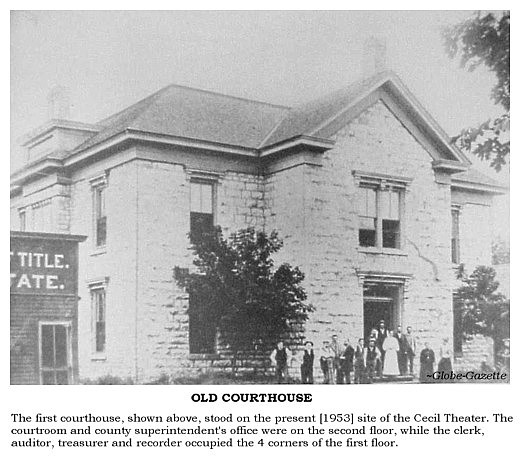
By 1890 the county business had outgrown the old courthouse west of the park and agitation started for a new building. Not until 1899, however, was the courthouse, which now [1953] serves the county, erected. That the present courthouse site was selected for the building is an interesting part of the record. This half block was acquired by the county in June, 1858, from George Brentner at a time when the supervisors apparently believed that the county had forfeited its right to the "courthouse square" (block 26) originally given the county for that purpose. On Sept. 7, 1880, the supervisors proposed bonding the county for $30,000 to build a new courthouse. Voters snowed this proposition under by 1,314 to 653 at an election on Nov. 2, 1880. Upon being convinced the courthouse vaults were inadequate and that space was insufficient for county offices, the board of supervisors on Sept. 5, 1881, decided to submit to the voters on Oct.11, 1881, the proposition: "That the sum of $20,000 be raised by taxation for the purpose of erecting a suitable courthouse." This lost by a vote of 840 to 447. Judge J. W. Ruddick of the district court bench then called the attention of the grand jury to the "delapidated condition of the courthouse and insecurity of the records and public documents of the county now in the rooms and vault of the courthouse." The same complaint was to be heard again 50 years later after another courthouse had been built. The grand jury urged the supervisors to call an election to raise $25,000 for a new courthouse. The supervisors set the election for June 7, 1882, when the proposition lost by a larger margin than ever, 1,453 to 421. Finally on Nov. 7, 1899, the county was in a mood for a new courthouse and voted 1,777 to 1,260 to erect at $64,000 building of Bedford stone. This is the courthouse that still [1953] serves the county, which now is inadequate for the needs of county officers.
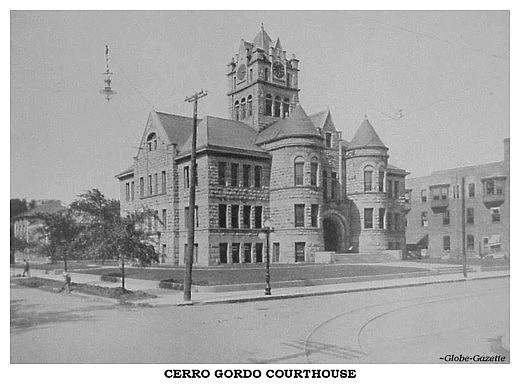
It featured turrets and a tall clock tower. This building served Cerro Gordo County until 1960
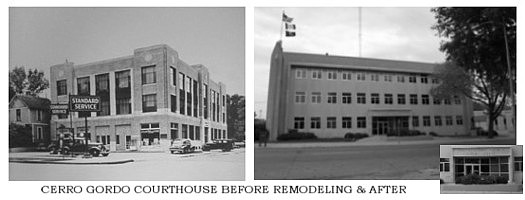
RELIGIOUS REVIVALS BUILD CHURCHES
In Mason City's history, there have been recurring periods when interest in religion reflected itself in expaning church membership and willingness to undergo sacrifices to build beautiful churches. One such period occurred as the 19th century neared its close. Several large churches were built, some of them standing today among the leading houses of worship in the community.
Evangelistic meetings were an effective means for raising church membership in those days. It was usually at a successful revival series that the groundwork was laid for enlarged membership and larger church buildings. Whole families from many miles around came to these meetings and sometimes stayed for days. Exhortations and threats and joyful singing were a part of the services. The repressions stored up in the lonely lives of toiling men and women found an opportunity for release in these religious experiences. An example of the effectiveness of such meetings was shown in the early winter of 1884 when Peter B. Billhorn held gospel services in Mason City. A skating craze was on and attendance by young people at the Billhorn meetings was as low ebb. One Saturday afternoon the singing evangelist brought a portable organ to the rink and began singing: "Rescue the Perishing" and "Let Your Lower Lights Be Burning." Some listened while others scoffed. Then someone threw a snowball that knocked Billhorn's hat, but the continued singing. A moment later a huge piece of ice and snow struck him in the face and knocked him unconscious. When the evangelist was revived he had a sympathetic audience. He played and sang until past midnight and the next morning (Sunday) the church was crowded and a most successful revival followed. These revivals proved effective in raising church membership, often as much as 50 per cent. It was following the great Barclay revival of 1873-74 that plans were set in motion by the Methodists for the erection of the large stone church on Washington and 2nd N. W. On March 10, 1875, the new church was dedicated. A great sunrise prayer meeting was held sponsored by the Epworth League, then at its zenith. The Rev. B. I. Ives of Auburn, N. Y., preached the dedicatory sermon. At its close, a financial statement was presented and Doctor Ives asked for the $12,000 to clear the church debt, revealing the total cost of the building was in excess of $40,000.
The first services were held in private homes and later in the Lloyd and Tuttle hall (on the site of Montgomery Ward [1953]) and the courthouse. It 1887 a church was built at 146 Sixth S. W., which was occupied until the congregation could take over the downtown stone church from the First Methodists.
NOTE: Rev. Calvin LaDue, a Congregational minister, came from Polk County, Iowa,
with his wife "Marilda" (Sanford) LaDue and family in 1870. They established their homes in what became to be known as LaDue Grove, approximately 2 1/2
miles northwest of what would become Fertile, Iowa.
Rev. LaDue was born in 1841 at Canada, and died September 30, 1891. Olive "Marilda" (Sanford) LaDue was born in New York
on September 22, 1840, and died on November 15,195. They were interred at Concordia Cemetery, Fertile, Iowa. The First Congregational Church, also underwent phenomenal growth in this period. It assumed the support of its pastor in 1874 and the next year built a parsonage. In 1898 the congregation erected the present [1953] church on the parsonage site adjoining the original church. The building was dedicated Dec. 5, 1898, by the Rev. T. O. Douglas, Grinnell, during the pastorate of Rev. Charles H. Rogers.
On March, 1876, the committee contracted with Farrell, White and Lien to build the foundation for $580 with W. W. Blood to build and furnish the structure for $4,050. On Nov. 19, 1876, the church was dedicated. On Feb. 8, 1895, this church was destroyed by fire. On the following August the cornerstone of the present [1953] building was laid and on May 10, 1896, the dedication took place. Among the early churches in the city was the St. John's Episcopal, which was organized in 1871 and incorporated in 1877 by the following vestrymen: T. B. McNider, grandfather of Gen. Hanford MacNider; J. H. Valentine, W. W. Cameron, M. S. Schermerhorn, J. F. Bush and William Barnard. In 1882 the parish purchased a lot on the corner where the YMCA now [1953] stands and built a church, which served the congregation until the present structure was built in 1930. With the coming of Father Carolan in 1877 the name of the Catholic parish on 5th S. E. was changed to St. Joseph's, the name which has since been retained. One of the achievements of this priest was the erection of the St. Francis Academy at Connecticut and 5th S. E.
Services were held at the courthouse and the opera house while a new church was being erected at a cost of $25,000 on North Federal and 4th. This church was dedicated May 7, 1893, by F. M. Fains. The building, which was later enlarged, was destroyed by fire in 1916. While other church groups had no language tieups, the beginnings of the Lutheran Church were associated with the coming of families of Scandinavian and German descent to Mason City. The Scandinavians in July, 1871, organized Trinity Lutheran church at the home of Andrew Helgesen. The first deacons were Andrew Helgesen, Martin Andeberg, Peter Olson and A. T. Lien, and the trustees, Henry Bricksen and N. M. Nelson. The congregation was served by the Rev. Ostby of St. Ansgar and later by the Rev. O. Nilsen of Northwood. In 1888 the congregation joined with Austin and Hayfield, Minn., in a charge and procured the Rev. O. Glasoe as pastor. He was paid $125 and traveling expenses a year for a Sunday service each month. Up until 1890 the congregation was affiliated with the Norwegian Danish Conference of America, but on March 15 of that year it subscribed to the constitution of the United Norwegian Lutheran Church of America and sent A. T. Lien and Gust Nelson to the first annual meeting. In 1892 the congregation purchased the lot and the next year a church costing $2,474.94 was built by Chris Rye on the present [1953] site of the Labor Hall on Pennsylvania S. E.
The congregation was incorporated that year as the St. James Lutheran Church and a building committee appointed, made up of H. C. Reife, C. W. Paulus, William Henkel and George Rehm. A church was built at 502 Sixth S. E., at a cost of $3,000, which served until the new church on Maple Drive was completed early in 1953. The First Church of Christ, Scientist, also has it roots in pioneer Mason City. As early as 1889 services were held at the home of Mrs. Grace G. King and later at the home of Mrs. Elizabeth Kirk. In 1890 the group rented the IOOF Hall and on June 4, 1892, the First Church of Christ, Scientist, was organized. Signature on these articles of incorporation were those of Miss Elizabeth Denison, Mrs. Allie Brett and Mrs. Clare Caton Sirrine. In 1894 the second floor of the Union block, across Federal from Central Park was rented. During the occupancy of this hall the name of Mrs. Lily Emsley Markley appears as First Reader. Judge and Mrs. Clifford P. Smith became actively interested in Christian Science in the late 90's. In 1906 Judge Smith was called to Boston to become identified with the legal work of the Mother Church and he and Mrs. Smith both served as president of The Mother Church. As the community's religious, civic and social life matured there came into existence other organizations. In May, 1892, a group of men organized the Mason City YMCA with J. J. Clark, later to become district judge, as the head of the association. From the time of the first settlers, lodges had a part in community life. The Masons, who were a force in pioneer Mason City, organized in 1859, met in rented buildings until the temple was build in 1895 on South Federal and Second at a cost of $9,500. Another early fraternal order was the Odd Fellows, whose organization dates back to May 26, 1871. The lodge was incorporated in 1882 and at a special meeting on April 6, 1882, a committee reported the purchase for $3,000 of the property, on which was erected the present [1953] three-story lodge hall in 1895 for $12,600. The first women's club was the Maria Mitchell, started in 1870. In 1882 the Monday Club was formed. Both are still [1953] part of the social life of the community as are also the Sorosis Club, which was organized in 1888, and the Twentieth Century Club, in 1895. Later there were organized the Knight of Columbus, Knights of Pythias, Knights f Maccabees, Ben Hurs, Eagles, Court of Honor and the Yeomen.
ERA of GILBERT AND SULLIVAN
It was the era of Gilbert and Sullivan. Before the tumult of the giant industries burst on the community with the turn of the century, Mason City enjoyed a brief period that might be called the "cultural 90's." The motor car was still a dream. But the prairie had been conquered. Comforts and culture replaced pioneer hardships. There was time for expressions and appreciation of the artistic in drama and music. Along with these refinements were surroundings that made for tranquility and contentment. Nearly every family had a cow, a horse and buggy and a picket fence. Livery stables, city watering troughs and hitching posts were the forerunners of garages, filling stations and parking meters. Horses were not only an indispensable means of travel. They were a part of the social and recreational life of the community.
In the early days the Lloyd and Tuttle hall, built in 1871 on the [1953] site of the Montgomery Ward and Company Building, was the center of social and entertainment gatherings. There such home talent productions as "Mrs. Jarley's Waxworks" and "The Broom Brigade" were presented. When the Parker Opera House was built in 1883 by H. G. Parker and his cousin, A. T. Parker, the stage was set for greater things in entertainment. Full fruition of this period came in the early 90's with the presentation of light opera in which choirs of Mason City churches were recruited for singers and performances by professionals.
"Our opera company was largely recruited from the church choirs and many of our beauties were members of the church," wrote Quick in his "One Man's Life." "Hence a few of the best people were greatly scandalized. I think my friend Klinefelter (editor of the Republican) was responsible for a part of this high tide of reproach. Kline said - not in his paper, but where it circulated just as far - that in his judgment, the Episcopal ladies were the best dancers but the Methodists had the best legs." "So great the departure from the norm of churchy behavior was this deed of enrolling in an opera company, rehearsing, actually dancing, so wrought was the pastor of the Methodist Church in which I was a humble choir member, that he preached a terrible sermon in which he condemned yieldings to worldy tendencies in scathing terms." Toward the end of the century the Parkers brought a number of nationally known actors here for one-night stands, among them Ben Warner, Matty Evans and Lizzie Evans, all well known in those days.
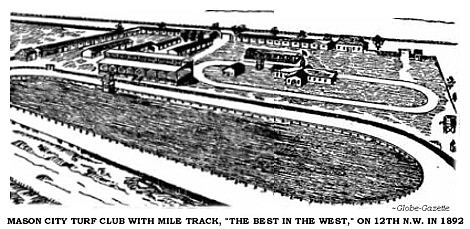
The part of the horse in the life of the "gay 90's" reached its highest expression in the famous Mason City Turf Club, an organization made up of owners of the finest horse flesh. Out of the Turf Club emanated Storm, fabulous racing stallion that won world titles and made Mason City known among horse men everywhere. Storm's achievements brought a fitting climax and triumph to Mason City's age of the horse. And because it was an age of the horse, it was a fascinating age. A man's station in life was measured by the type of horses he owned. The trading of horses was continually taking place. And determining the worth of horse-flesh could be as much more absorbing business than dealing in motor vehicle mechanism. In Mason City there emerged a group of business and professional men who wanted only the aristocracy of the breed. At one time there were 32 standard bred stallions owned by Mason Cityans, all bluebloods with famous ancestors. Horse racing was the sport of the day. Trotters and pacers flew back and forth over the Winneago River ice below the Taylor bridge. On May 26, 1891, the prominent men of the town drew up incorporation papers for the Mason City Turf Club, capitalized at $50,000. James Rule was elected president; L. A. Page, treasurer; D. J. Stewart, secretary; and C. M. C. Stewart, J. E. Moore and H. P. Kirk, members of the board. The club purchased 40 acres south of the old fairgrounds in what is now [1953] Hoyt's addition, bordering 12th N. W. to the north. John West was hired to build a $3,000 mile track. A grandstand costing $5,000 was constructed by Ade Randall. When completed late in July, 1891, the amphitheater had seats for 2,000. Stalls extending 900 feet were built to house 75 horses. Across from the grandstand was a platform above for newspaper reporters and telegraph installations.
Invitations went to all parts of the United States for the grand opening of the Turf Club Aug. 4, 5 and 6, 1891. On the early morning of the 4th trains brought sportsmen and racing fans from a large area. Included also were big time gamblers. Purses for the three day racing event totaled $4,000, one of the biggest ever offered in the Middle-west. Highlighting the first day's races was the winning of the featured mile by Fred K., which paced the track in 2.21 1/2. On the second day a pacer owned by Charles Savage was half a length in the lead when he dropped dead on the home stretch. Had the horse won he was to have been sold for $1,000 immediately after the event. Equally successful was the third day of an event and the slogan - "best in the West" - was generally adopted. Besides Savage, Mason City horse owners participated, including Jim Moore, Al Sphor, Harry Merrill, George Smith, Charles Smith, L. E. Cadwell, Nate Kotchell, H. P. Kirk, B. P. Kirk, Sine Keeney, C. M. Stewart, Ollie Felton, Cort Ransom and Mike Lombardo. Among the horses in the opening races was Storm, a beautiful coal black pacer, that finished third. He was purchased by H. P. Kirk and Burr Kirk when a year old from a Tennessee horse breeder. Burr Kirk trained the horse and Bob Ellis drove him at the races. The man who cared for Storm was William Dodson, a Negro. The combination was a natural. In three years they made Storm the fastest 5 year old in America. At the famous Independence kite-shaped track Storm set a record of 28 1/5 seconds for the quarter mile heat. In the fall of 1892 he won the main pacing events in Chillicothe, Mo., Terre Haute, Ind., and Nashville, Ten. At the Nashville track Storm gained entrance to horsedom's hall of fame by winning the three fastest consecutive heats ever won by a stallion of any age on a regulation track. Times made were 2:04, 2.09 and 2.08 1/2. The 2.08 1/2 time was recorded in the books at Nashville as the fastest time for a mile ever performed by a 5 year old. The return of Storm to Mason City after winning the three races was a gala occasion. All Mason City turned out for the ceremonies at the old Iowa Central station. Vern Kirk, then 13, led his father's horse up Federal with the band playing and the people cheering. In the spring of 1893 the Kirk brothers completed a business deal with an easterner who desired to buy Storm for $45,000. The night before Storm was to have been sent east a fire broke out in the stable. Despite all efforts of Burr Kirk and his son, Lyle, Storm could not be led from the blazing stable. The news of the fire spread throughout the city and the crowd stood watching the flames. Strong men wept like children. One of America's greatest horses had come to a tragic end. While Storm was making history, the Mason City Turf Club, which started with such fanfare, was having financial difficulties, as the great depression of 1894 set in. Excessive rain and poor roads cut down attendance in 1893. Club members had to borrow $7,500 from the bank to pay the prize money. Not long afterwards, as the first horseless carriages came over the horizon club activities ceased. As part of the age of horses a thriving livery business was going on in Mason City. Burr Kirk was among the pioneers, starting as early as 1859. He had 30 horses in his stables. Not long ago a two story red brick building was torn down to make way for a super market on First N. E. That building had stood since 1876 when it was built by L. F. Cadwell for a livery stable. After he died, his son, Art Cadwell, carried on the business. Across the street to the south from Cadwell on the present [1953] site of the Mutual Federal Saving and Loan Association building, stood the Cliff Baker livery barn, noted for the fine Arabian type horses. This was destroyed by fire about 1910. Simon Kenney operated a stable on South Commercial and on the present [1953] site of the city hall was M. Valentine's feed shed. The horse was still in his hey-day, but the time was near when he was to disappear from the streets of Mason City. NOTE: L. F. Cadwell was born on March 25, 1832, and died October 26, 1880, interment was made at Elmwood-St. Joseph Cemetery.
BRICE SETS STAGE for COMING BOOM

[Section 7, Page 20] The weather was ideal that Sunday morning in the spring of 1896 when the Iowa Central (M and St. L.) train rumbled into Mason City from Southern Iowa on one of its customary one dollar round trip excursions to Clear Lake. Among the passengers who got off at Mason City Junction to take the waiting Milwaukee train for the last 10 miles of the journey was Lew Ong, then a resident of Tama. "Will the Milwaukee train back into this junction?" he asked the conductor. Assured that it would, he entered the railroad cafe for a lunch. When he emerged the Milwaukee was disappearing over the hill by the cemetery. Then and there was born the idea for the Mason City and Clear Lake Railroad, out of which grew another important event - the building of the Chicago and North Western Railway through Mason City.
When he got back to Tama, Ong, who was then 32, went to see 35-year-old W. E. Brice, whose family operated a trading post dealing with the Indians. A few nights later, July 13, the Mason City Council was in session, presided over by Mayor A. H. Cummings. Among those present was C. T. Dike, part-time city engineer.
Watching the proceedings was Dike, who had tried ever since he was graduated in engineering from Cornell to get a job as a railroad engineer. Perhaps this was his chance. Early the next morning he was at the hotel to see Brice, who first told him he didn't need an engineer, but later hired him.
The country was deep in a depression."Coxey's Army" had marched on Washington. Millions of men were out of work. Corn was selling for seven cents a bushel. But Brice was looking into the future and was willing to gamble on it. By the end of June, 1897, the construction was completed. Ong took over the job of superintendent and on the following July 4, the first excursion in open cars was run to Clear Lake. Sitting in the front seats were Brice, his wife, Minnie, and their spaniel, Sanko. During a stop at Emery, mid-way point, Sanko got away and started after birds, with Brice and Dike chasing him for several minutes holding up the whole train. With the road finished Brice proposed to sell bonds to pay his creditors. Bond firms were invited out to look over the railroad. Prospects looked good until one of the prospective buyers asked about connections with other lines. Brice produced a letter from the Iowa Central agreeing to ship over the road for an unspecified time. This was not considered binding enough and the bond house representatives departed, leaving Brice with a huge debt. The need for more extensive connections for the Mason City and Clear Lake Railroad now became urgent in order to finance the project. When Dike returned in the spring of 1898 from a trip to the southwest, Brice suggested the extension of his unterurban southward from the lake. After a survey by Dike this was abandoned. It was then suggested the line be extended north. Dike drove northward from the lake to Fertile, where he contacted the miller, Rhodes. "Why don't you build a railroad from Mason City to Fertle, following the Lime Creek and extend it to Lake Mills," asked Rhodes. Dike stayed over night in Fertile and the next day drove over the country in that area, finally reaching Lake Mills. There he was told to see Ole Scar, a merchant. Ole, a bachelor, took Dike up to the second floor of his store and produced a map of the territory north of Lake Mills, showing an area from 35 to 40 miles square without a railroad.
Dike and Scar drove over this area. The farther they went the more excited Dike became. It was evident that here was an opportunity for a railroad through Lake Mills to Blue Earth, Minn., and beyond. Returning to Mason City, Dike got Brice out of bed at 6 the next morning to tell him the news. They went to see C. H. McNider, and organized the Iowa, Minnesota and Northwestern Railway Company. Dike was named chief engineer and given funds with which to purchase instruments and to hire assistants for a survey of the right-of-way. Among his young assistants were Chet Stevens, later to become city engineer, and Harry Keerl. Chainmen were paid $15 a month. The surveying and right-of-way acquiring party drove to the vicinity of the present town of Joice to begin work so as to arouse as little attention as possible. Surveying continued to Blue Earth, Minn., and back to Mason City.
NOTE: Chester Thomas Dike was born August 13, 1870, and died August 2, 1958. Bonnie (Elder), Dike,
his wife, was born May 9, 1875, and died August 13, 1966. They were interred at Elmwood-St. Joseph Cemetery. The town of
Dike, Iowa, was named after him. Dike chose the site and laid out the town in 1900. The town, whose motto is "A Slice of
Iowa," was incorporated January 16, 1901.
It was then decided to extend the line southeastward to Cedar Rapids, where it would connect with other railroads, to one of which Brice hoped to sell. Dike, however, found that going into Cedar Rapids would require too heavy a grade so he surveyed the line to Belle Plaine instead. By this time other railroads were taking notice of the project. In the spring of 1899 President Ives of the Burlington, Cedar Rapids and Northern (Rock Island), which had a line from Manly to Cedar Rapids, let it be known that there were railroads enough in that area. Associates suggested that Brice see President Marvin Hughitt of the Chicago and North Western at Chicago. But Brice was certain all railroads would try to boycott the Mason City venture. The only solution, he believed, was to get a reputable contractor to take bonds for the job and proceed with the building of the railroad. In the quest for such a contractor Dike went to the firm of Foley Brothers and Guthrie at St. Paul, largest in the business, and bearded Mike Foley in his office. "You have a wonderful line and I suggest you go and see Hughitt, he will snap it up immediately," said Foley after looking over the maps and engineering figures. Foley's prediction proved true. Brice went to see Hughitt, who accepted the proposition and sent his engineer E. C. Carter to consult with Dike and to engage contractors. Included in the contract was the provision that Brice was to have the townsites and sell lots. It was Dike's job to determine the locations of all the stations. The stations along the railroad were named after Brice and his associates: Bricelyn for Brice; Wheelerwood for J. S. Wheeler; Hanlontown for F. J. Hanlon, secretary of the company; Scarville for Ole Scar; Joice for P. M. Joice, Lake Mills banker; Vorhies, for W. H. Vorhies, Iowa Central conductor; Hanford for Mrs. C. H. McNider; Eleanor for Mrs. J. E. McDonald; Keister for Jacob Kiester; Frost for Forst of Chicago; Zaneta for Zaneta Eager, daughter of a bookkeeper on the new railroad; Cartersville for North Western chief engineer; and Doughtery for the Dougherty family. When all the stations had been located - except one - the second one beyond Parkersburg - Brice went down to talk the matter over with Dike. Dike showed him the proposed townsite. It was in a low spot full of slough grass. "If this station is put in the right place I could make $20,000 on the sale of lots," said Brice getting indignant. "If you put in in that hole," he added, "I'll call it Dike." "I'll be pleased to father this town," answered Dike. "You think it will be a failure. I think it will be the best in the lot."
The building of the railroad set the stage for a huge business and industrial expansion in the next few years.
NOTE: William Ellsworth Brice was born July 26, 1861, Rochelle, Illinois, the son of James Jr. and
Sarah (Hill) Brice, came to Mason City in 1896, and died at the age of 89 years, Mason City, on December 29, 1950.
Minnie (Tallon) Brice, his wife, was born in Montrose,
Pennsylvania, and died October 5, 1938, Mason City, They were interred at Oak Hill Cemetery, Tama, Iowa.
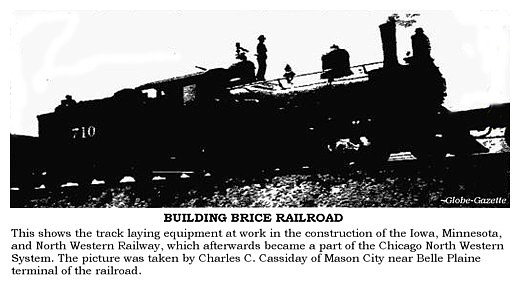
GIANT INDUSTRIES TRANSFORM CITY
That day Jacob E. Decker and his son, Jay, bought a small slaughter house that was to develop into the great industry of Jacob E. Decker and Sons. The plant was purchased from J. T. Richards, who had started it some three years before. There were other evidences in 1899 that Mason City was on the eve of greater things: That year, through the astute operations of W. E. Brice, the North Western Railway was built through Mason City, opening up vast new territory. That year the names of both Muse and Conroy went up on the masthead of the Mason City Globe-Gazette. And that was the year the dream of a beet sugar plant looked real, but wasn't to materialize until 17 years later.
Reports of geologists showed heavy deposits here of calcium carbonate for cement making and the possibility of another great industry loomed. At the same time the brick and tile industry under the genius of O. T. Denison began seeking new outlets that were to make it nationally known. The Deckers brought to the packing plant wide experience in the business. Theirs was a family of meat packers reaching back at least seven generations. One of Jay's proud possessions is the butcher certificate issued to an ancestor, Johan Jacob Decker, at Neuwied-on-the Rhine, Germany, Aug. 24, 1877. Jacob Decker had for many years operated a meat business in Chicago. There Jay got his start, going in 1896 to Austin to work for his cousin, George A. Hormel. It was Jacob E. Decker's eagerness to get his sons, Jay and Ralph, into the business that led to the purchase of the Richards plant. The building that housed the young industry was rented for $50 a month and later purchased from the Commercial Bank for $6,000. The plant's capacity at the start was 11 hogs a day. The hogs would be slaughtered one day and the meat cut the next. First year's output was 500 hogs.
Refrigerated transportation was a big boon to the industry and made possible wider distribution until Decker hams became known throughout the land and even abroad. This industry grew to a giant because it served the large North Iowa agricultural area. Other industries of its kind were to follow. As the Deckers took over the packing plant O. T. Denison and D. W. Hurn were trying to interest eastern capital in building a beet sugar plant here. Experiments revealed the soil of the area was ideal for sugar beets.
NOTE: Jacob Emil Decker was born in Neuweid, Rheinland-Pfalz, Germany on April 1, 1849, the son of Ludwig
Gottfried and Anna Maria (Boecking) Decker, came to America with his family in 1852, came to Mason City in 1899,
and died in August of 1921, Mason City. His wife, Augusta (Schram) Decker,
was born in Kreis Greifenberg, Germany September 7, 1851, arrived in America with her family in 1860, and died in Mason City, February 18, 1946. They were interred at Elmwood-St.
Joseph Cemetery. Not until 1916 was the dream of a sugar factory realized. That year newly formed Mason City Chamber of Commerce raised $25,000 for the purchase of a site and entered into negotiations with H. A. Douglas of Detroit for a sugar factory. The Chamber made available a 50 acre tract, part of the B. A. Balmat farm, north of Mason City. The factory was erected and W. H. Baird, father of Bil Baird, came as manager and E. C. Moore as agricultural superintendent and later manager. In 1925 the plant, which up to that time bore the name, the Northern Sugar Company, was purchased by the American Crystal Sugar Company. Mason Cityans were award of cement potentialities here years before the coming of the factories. In promotion literature of 1900 this prophetic statement appeared: "A cement plant in Mason City would make a fortune for its owners, as a market exists at its very doors for all that could be produced. A big plant for the manufacture of cement is among the industrial possibilities of the near future." It was about this time that Walter J. Maytham, chief engineer for W. J. Cowham, Jackson, Mich., cement plant promoter, came to make a survey. On the strength of Maytham's report, Cowham directed Maytham to design and proceed with the erection of the Northwestern States Portland Cement Company plant in 1906. Maytham came to Mason City to continue as chief engineer of the company, Fred Smith took over the job as superintendent, which he has continued to hold. The plant had a 3,500 barrel a day capacity at first but present [1953] capacity is 6,000 barrels or 24,000 sacks. Shipment of cement started in 1906. Since then something like 300 million sacks of cement have been made. The land on which the plant was built and which provided the early limestone requirements - a 286 acre farm - was purchased from C. H. McNider, who took stock in the company as payment. Much of the common stock was given free with the purchase of preferred and the first years of operation the company had rough going. McNider took over management of the company when it was in financial difficulties in 1911. Preferred stock dividends were in arrears and debts were piling up. Under McNider's management dividends were paid up, a $6000,000 bond issue paid off and a $1,750,000 preferred stock issue retired. C. H. McNider personally never owned a large amount of stock in the company. At the time of his death he held 406 1/2 shares out of a total of 35,000 outstanding. After the death of C. H. McNider in 1928, W. H. McCourtie, one of the original promoters of the property, assumed the presidency, but during the one year he served as head of the company. Hanford MacNider with a group of associates purchased the holdings and since then the MacNider family has held the largest single block of stock in the company. In 1910, after an extensive survey of the situation, the Lehigh Portland Cement Company, acquired the W. A. Russell farm north of Mason City and on it erected a cement plant with a capacity of 5,000 barrels a day. The Lehigh plant was opened with Oscar Davis as superintendent. He continued in that capacity until 1933 when he retired and was succeeded by W. H. Patterson. Patterson was followed by Arnold Johnson and at present [1953] George Hannaman is plant manager. The Mason City brick and tile industry reached giant proportions in the first two decades of the century. When it became established that tiling of Iowa's farms would increase their productivity, the demand for drain tile sky-rocketed to the point where Mason City became the world's largest producers of this product. To meet this demand plant after plant in the southwest part of the city, where a 40 foot deposit of blue and yellow clay provided what appeared to be an inexhaustible supply of raw material.
In 1912 Denison and Keeler gained control of the two plants of the American Brick and Tile Company, which had been organized in 1900 by heads of the City National Bank and had 110 aces of clay land and 33 kilns. A year later the one plant of the North Iowa Brick and Tile Company, with its 148 acres of land, was taken over by the Denison-Keeler organization. This plant was started in 1906. The National Clay Works, organized as the Farmers Co-Operative Company in 1909, headed by J. H. Brown of Rockwell, was the last of the independent companies to be absorbed by the Keeler interests, but not without difficulties which culminated in a law suit against Keeler at a time his fortunes had suffered from the depression in 1933.
NOTE: William Hobart Patterson was born January 23, 1897, and died September 15, 1988. Gladys Ellen Patterson,
his wife was born March 26, 1896, and died January 1, 1970. They were interred at Elmwood-St. Joseph Cemetery.
The large Ideal Sand and Gravel Company was started by Grant McGowan and F. A. Stephenson in the northeast edge of Mason City in 1916 in the midst of huge deposits of sand and gravel made during the glacial epoch. In 1924 McGowan bought out the Stephenson interests and since then the plant has been operated by the McGowan family. Several million tons of sand and gravel have gone out of the pits of this company for the huge paving program in this area and for many other construction uses. NOTE: U. Grant
McGowan was born May 18, 1873, and died August 20, 1957. His wife, Maude B. McGowan was born December 28, 1965, and
died May 24, 1958. They were interred at Elmwood-St. Joseph Cemetery. Fortunately for Mason City, the electric power facilities here have been ample for the growth of its industries. This became particularly true from 1900, the year W. E. Brice purchased the plant from Mrs. M. I. Clark. In 1913 Brice sold out his utility holdings, the gas and electric plant and the Mason City and Clear Lake Railroad to the United Light and Railway Company. Brice retained the presidency of the Mason City subsidiary, which was named the People's Gas and Electric with C. H. McNider as vice president and F. J. Hanlon as general manager. In 1901 Mason City became the home office of the Western Electric Telephone System, which had been organized in Britt in 1895. While in Britt the company built toll lines through northwestern Iowa, southeastern South Dakota and southwestern Minnesota, being the pioneer organization for much of this territory.
On June 1, 1929, the Western Electric was consolidated with the Northwestern Bell Telephone Company, which for some years had owned the majority of the stock. By that time the Western Electric Company assets totaled $5 million and 57,164 telephones. B. C. Way was named a vice president of Northwestern Bell. While W. F. Muse and David Conroy made their purchase of the Mason City Globe-Gazette in 1898, Muse did not join the organization until 1899 because of a concert tour of the Ottumwa quartet in which his famous bass voice figured prominently. The two young Ottumwa journalists made a success from the start. Muse became the editor and Conroy the business manager. Muse proceeded on the theory that success would depend on a superior news service, particularly in local coverage. This proved a sound premise for one by one the rival newspapers began to fall by the way-side. Soon after the Muse and Conroy rival Will Ed Tucker suspended the publication of the Express, Burleigh Milton sold the Star to E. W. Trezise but it was later absorbed by the Globe-Gazette. "Charlie" Myers disposed of his plant, the Republican, to the Times-Herald, the other daily newspaper. With the Globe-Gazette weekly being absorbed in the daily, there remained the struggle between the two dailies. In 1918 the Times was purchased and merged with the Globe-Gazette. The Globe-Gazette some years before this had built the three-story building on First and Delaware S. E., now the Globe-Gazette apartments, which it occupied until 1921, when it moved it its present location.
Unless otherwise noted, photographs courtesy of The Globe-Gazette. Some of the photographs did not scan well. In such a case the photograph has been substituted with a clearer copy if available. Transcriptions and Notes by Sharon R. Becker, December of 2014 Information obtained in notes from cemetery transcriptions, obituaries, biographies & other Globe-Gazette articles
|
"Mason City Story" ~ INDUSTRIAL EXPANSION 1899 - 1920 "Mason City Story" ~ DEFLATION-INFLATION YEARS 1920 - 1953 Return to Centennial "Mason City Story" Index Page Return to Mason City Centennial Index Page Return to History Index Page Return to Cerro Gordo Home Page